Art From the Romantic Period John Everett Millais Ophelia Paintings
The Language of Ophelia'south Flowers

and a translation of the language of Ophelia's flowers
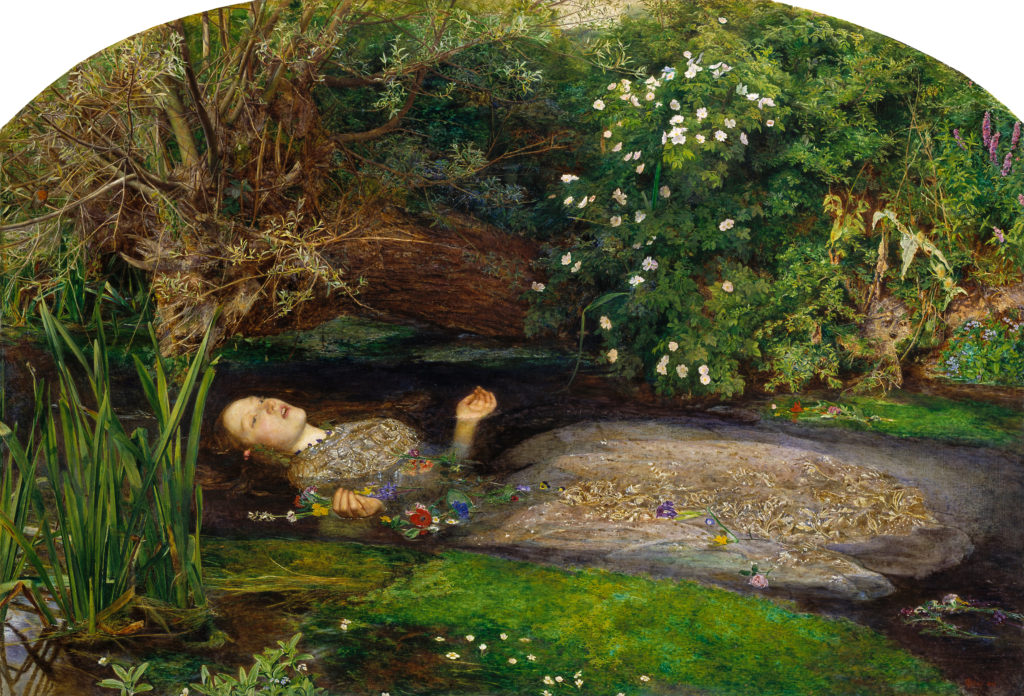
There is a willow grows askant the brook,
Hamlet, Act IV Scene Vii
That shows his hoar leaves in the burnished stream.
Therewith fantastic garlands did she brand
Of crowflowers , nettles , daisies , and long purples
That liberal shepherds give a grosser proper noun,
Just our cold maids exercise dead-men's-fingers call them.
Botanical symbology was significantly utilized in the plays of Shakespeare and the paintings of the Pre-Raphaelites. With this shared reverence for the linguistic communication of flowers and their true observation of nature, the pairing of mediums, as exemplified in the painting to a higher place, formed timeless visuals of universal themes. Heeding Ruskin'southward tenets of aesthetic, "torefuse nada,select nothing, and contemptuousness nothing" in nature, the Pre-Raphaelites depicted Shakespeare's words in painstaking detail (Barnard 4). And no painting amend exemplifies this fidelity to the biodiversity of Shakespearean settings than John Everett Millais' Ophelia.
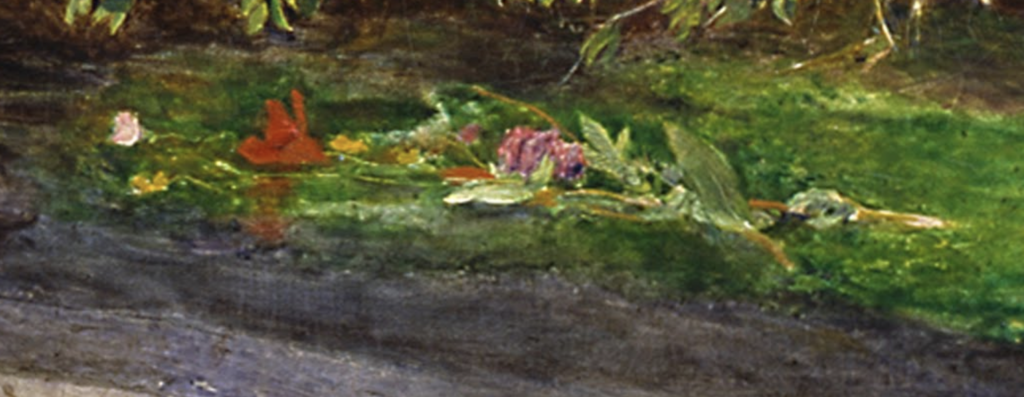
In 1851, Millais set up out for Hogsmill River in search of an embankment to lay the scene of Ophelia's drowning (Riggs). Through the lens of Pre-Raphaelite ideology, Millais began to breathe life into the haunting scene of Ophelia'due south demise as he practical the structural and textural details of the English riverside to canvas. From the gnarled bole and boughs of the crevice willow to the algae flowing similar the pilus of a h2o nymph, Millais beautifully encapsulated the floral symbology of Hamlet as understood in the Victorian Era. In improver, he included several significantly symbolical flowers, such as the cherry poppy and forget-me-nots, to intermix with the botanical references in Gertrude'due south monologue.
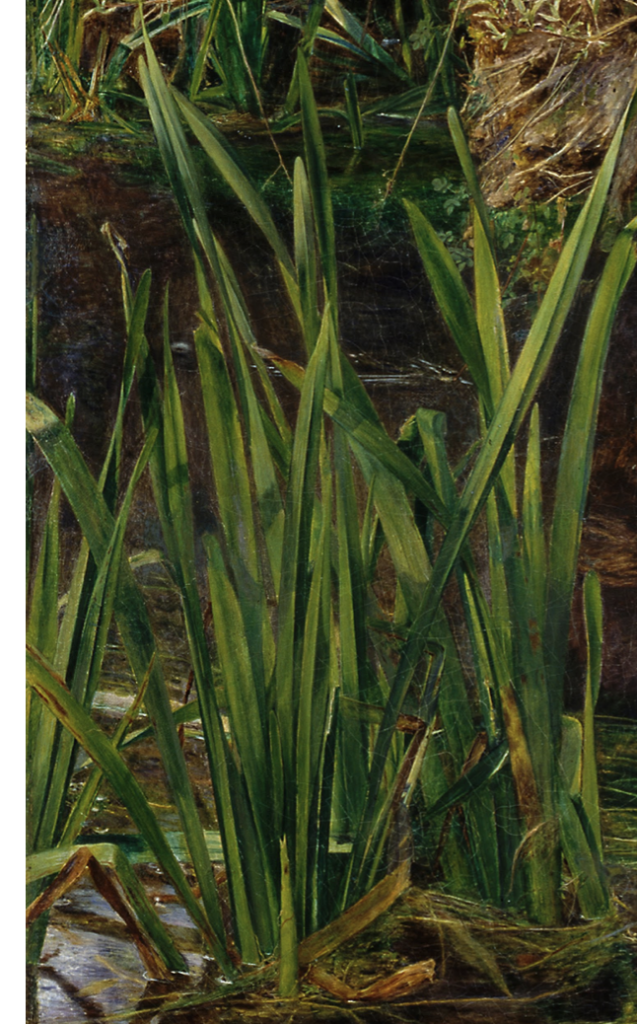
In order to understand the complete story Millais has told through the trailing "weedy trophies," I have analyzed the significance of the flowers during both the Victorian and Elizabethan eras. The ceremoniousness of investigating the significance of botany during the Elizabethan Era is not just in relation to the context of Shakespeare's life, merely too the role Queen Elizabeth I played in the publication of books on botany and gardening (Quealy 12).
Along with the confirmed botanical symbology made in both Shakespeare's Hamlet and Millais' Ophelia, I accept included many of my own surmises on the diverse floral arrangements floating on the boil that have nevertheless to be explored.
Below, you will find a list of 28 botanical references I take analyzed in alphabetical gild:
Asphodel
1.
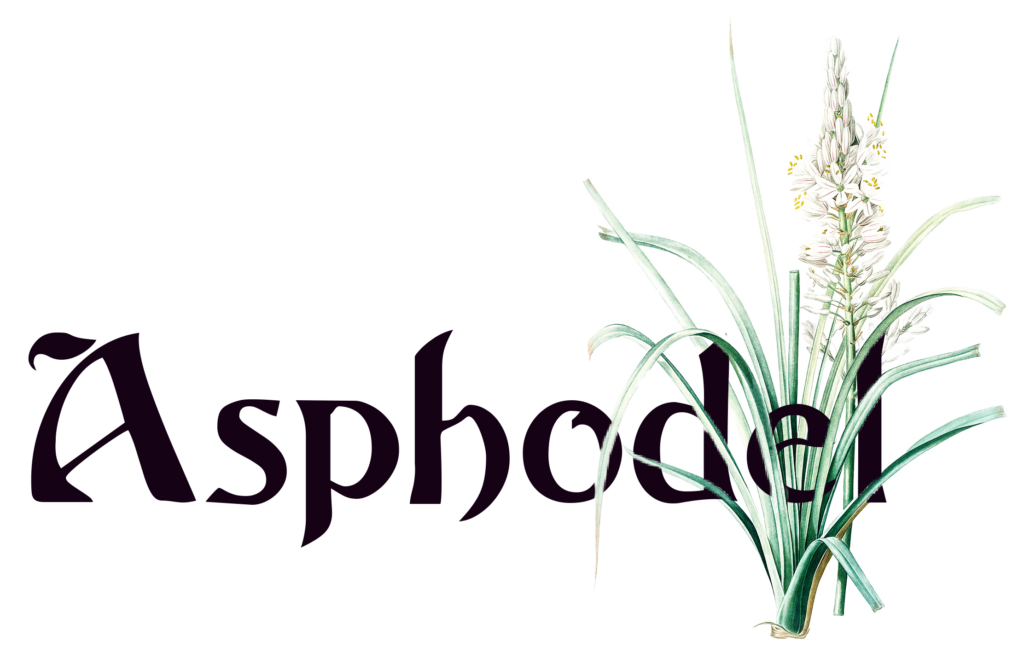
Victorian Pregnant of Asphodel: My regrets follow you to the grave.
My starting time try at identification begins with the White-Flowered Asphodel (Asphodelus albus) that I believe to exist depicted in Ophelia's right hand. Asphodel, also known every bit "rex's spear," was brought to England in 1551 and was idea to be the "food of the dead," thus it was planted throughout cemeteries (Graves 328; Belanger 278). Though the traditional use and Victorian meaning of asphodel strongly supports my conjecture, I am convinced that it was likewise used as a literary innuendo, which I will farther elaborate on in a subsequent blog.
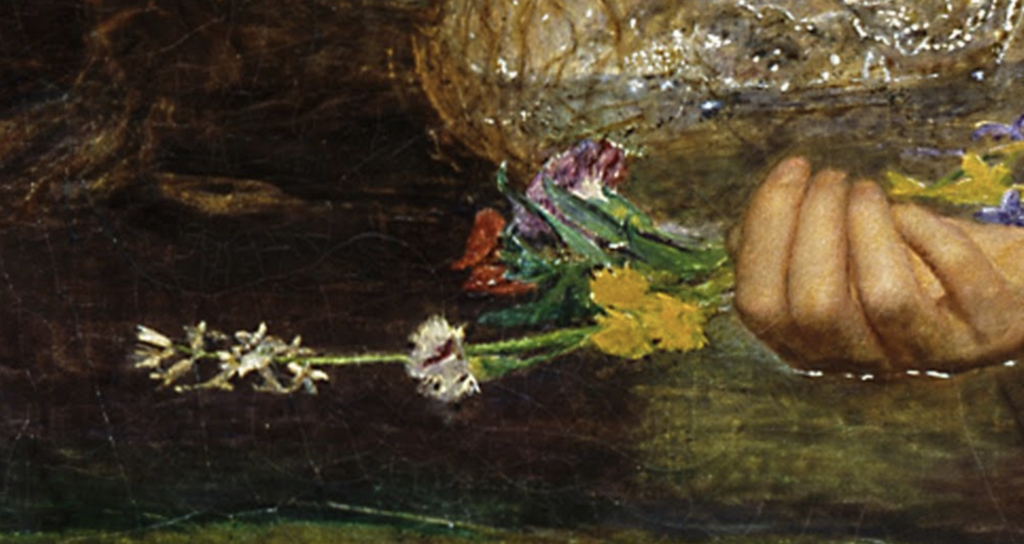
This perennial'due south clan with death was first recorded in the oral lore of Aboriginal Greece (Reece 392), which is revealed in the asphodel meadows of the underworld equally depicted in The Odyssey:
"And Hermes the Healer led them on, downwardly the dank, moldering paths and past the Ocean'due south streams they went and by the White Rock and the Sun'due south Western Gates and past the State of Dreams, and presently they reached the fields of asphodel where the dead, the burnt-out wraiths of mortals brand their dwelling house."
Homer, The Odyssey
". . . the ghost of clean-heeled Achilles marched away with long steps over the meadow of asphodel."
Homer, The Odyssey
Here are simply a few more references to further convince y'all of the powerful symbology of the asphodel:
"The dead are fabricated to eat asphodels about the Elysian meadows."
Sir Thomas Browne, Urn-Burying (1653)
"Others in Elysian valleys dwell, Resting weary limbs at last on beds of asphodel."
Alfred Tennyson, Lotos-Eaters (1832)
"The tints of the green carpeting deepened; and when, one by one, the white daisies shrank away, there sprang up in place of them, ten by x of the red-red asphodel."
Edgar Allen Poe, Eleonora (1850)
"I had buried my romance in a bed of asphodel."
Oscar Wilde, The Moving picture of Dorian Grey (1890)
"There asphodels are scattered through the night, similar ghosts of immature beseeching hands."
William Faulkner (scribed with drawings he fabricated in 1919)
"And he who wore the crown of asphodels,
Descending, at my door began to knock."
Henry Wadsworth Longfellow, The Two Angels
"I was cheered when I came offset to know that in that location were flowers too in hell."
William Carlos Williams, Asphodel, That Greeny Flower (1955)
Baby Blue Eyes
The Language of Ophelia'due south Flowers
two.

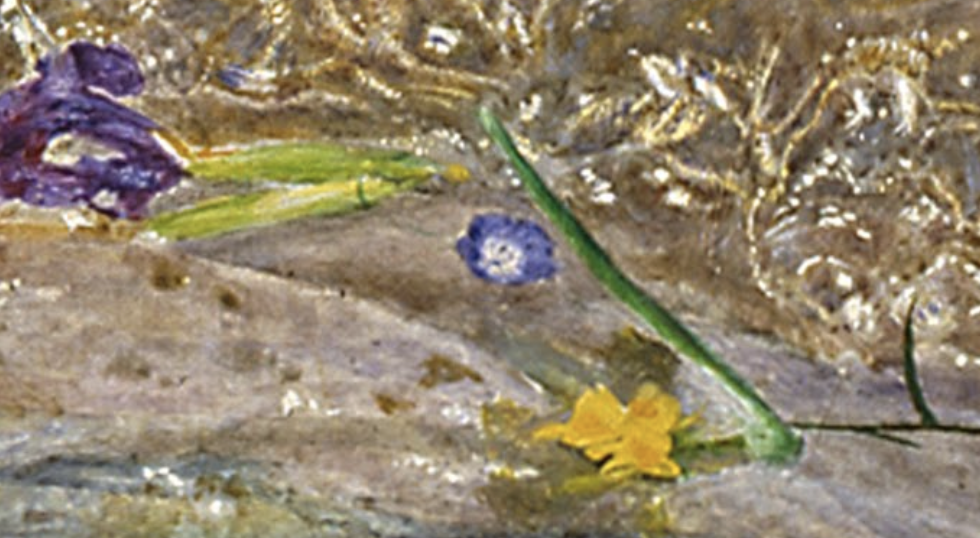
Though this dainty California native wildflower was readily available for garden cultivation in England, I have even so to locate a credible source with the Victorian symbology of Nemophila. Nevertheless, I am yet determined to make a claim that the pocket-sized blue blossom clearly represents a Baby Blue Eyes (Nemophila menziesii).
Briar Rose
3.
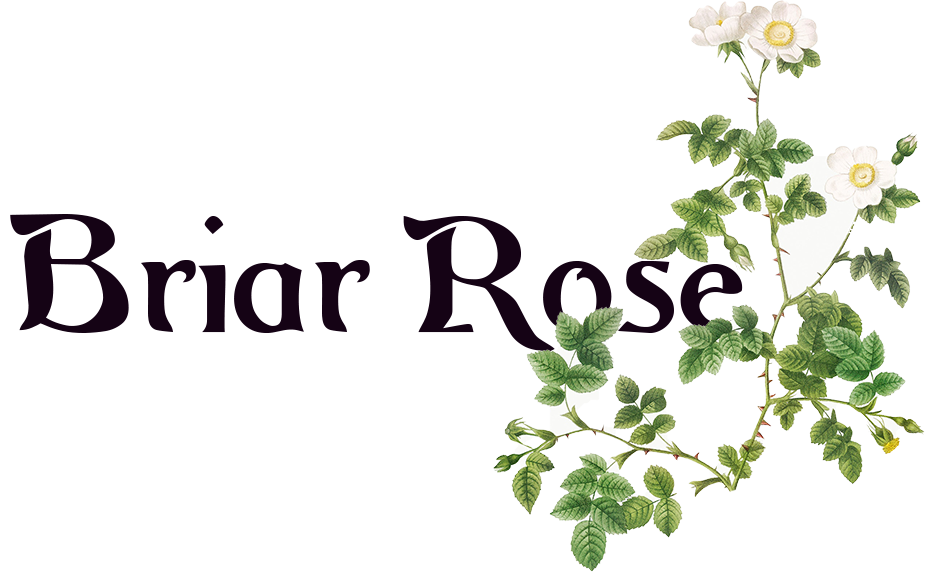
Victorian Significant of Canis familiaris Rose: Pleasance & Pain
The wild roses Millais refers to every bit dog roses are interchangeable with the proper noun Briar Rose (Rosa carina), a symbolic rose oft utilized in depictions of the folktale Fiddling Briar Rose, as well known as Sleeping Beauty.
In Elizabethan times, this wild rose, originally spelled every bit "brier" often referred to any wild plant with thorny stems, like the blackberry brier, or abrupt elements, like the Hawthorn (Ellacombe 35).
Buttercup
The Linguistic communication of Ophelia'southward Flowers
iv.
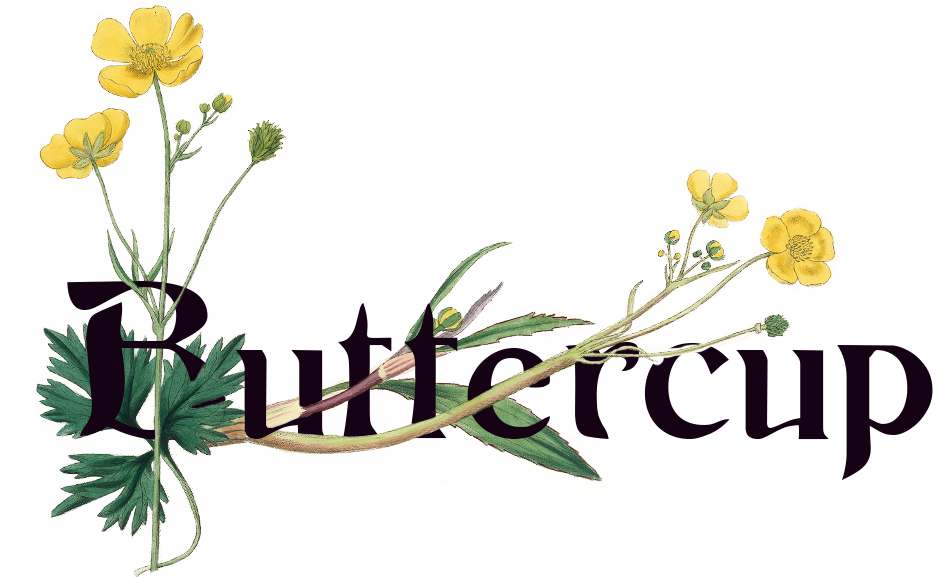
Victorian Significant of Crowfoot & Buttercup: Ingratitude
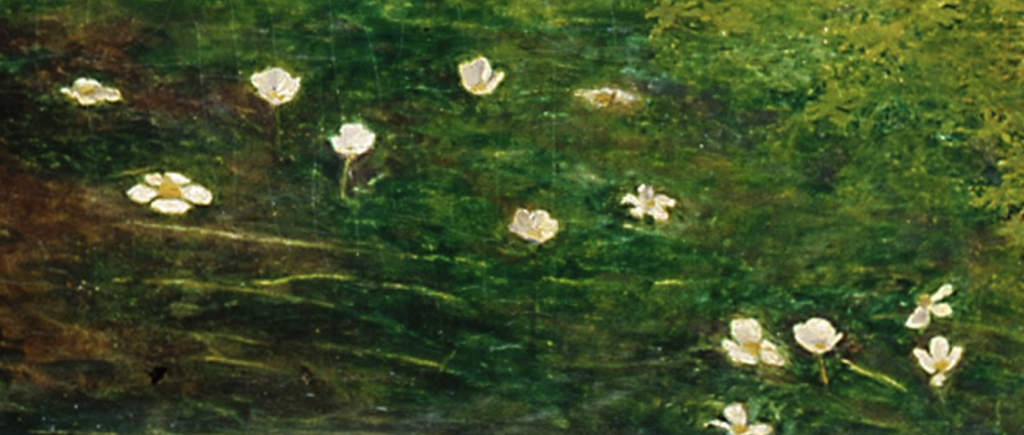
I am in full agreement with the Plant Curator'southward identification of the lower right flowers equally Stream Water Crowfoot (Ranunculus penicillatus), blooming amidst the conglomerate of algae. According to the Online Atlas of the British and Irish Flora, this relative of the buttercup (Rancunculus), is constitute in "flowing rivers and streams," which may mean they are present forth the embankment of the Hogsmill River. Though Victorians referred to the buttercup as a crow-flower, Elizabethans identified the Ragged Robin (Lychnis flos-cuculi) as the crow-flower, which I discuss in length afterward (Ellacombe 64).
The Language of Ophelia'southward Flowers
5.
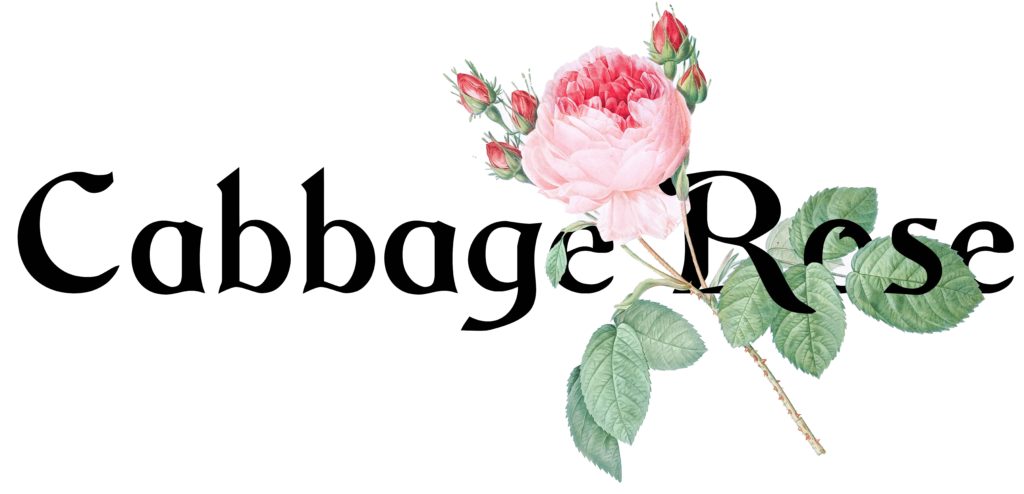
Victorian Meaning of Cabbage Rose: Ambassador of love
"The Rose is a cute flower, but it ever fills me with sorrow by reminding me of my sins, for which the Earth was doomed to bear thorns."
Saint Basil
The ii roses depicted past Millais seem to resemble the course of the Cabbage Rose (Rosa centifolia), as well known every bit the Provence Rose, which were introduced to England prior to Shakespearean times (Ellacombe 266). In addition, John Gerard's Herball, a phytology book utilized past Shakespeare, refers to the Provence Rose as the Holland Rose, also known as the Cabbage Rose (Quealy 202).
"With two provincial roses on my razed shoes."
Village, Human activity III Scene II
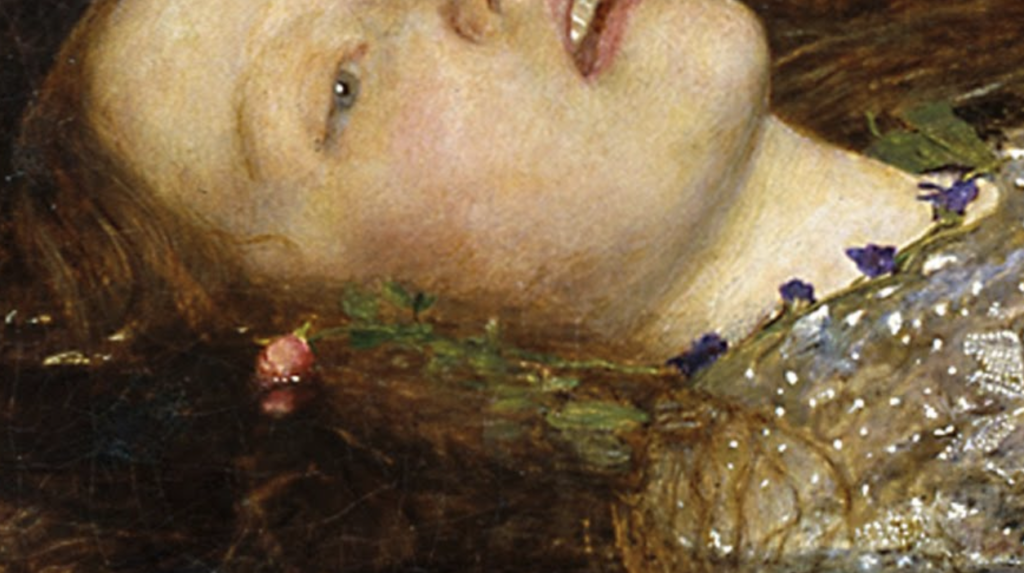
The frail rose buds that lay by her cheek and wearing apparel represent youth, love and beauty. Even so, some roses were used every bit a handling for madness and symbolized youthful death (Ellacombe 264).
The literary meaning of the rose is almost eloquently described past Ellacombe:
" . . . the Rose is but the emblem of all that is loveliest and brightest and most beautiful upon globe, yet always with the underlying sentiment that even the brightest has its dark side, every bit the Rose has its thorns; that the worthiest objects of our early on dearest are at the very best but short-lived; that the almost beautiful has on it the doom of decay and expiry."
Henry Ellacombe, The Plant-Lore and Garden-Craft of Shakespeare
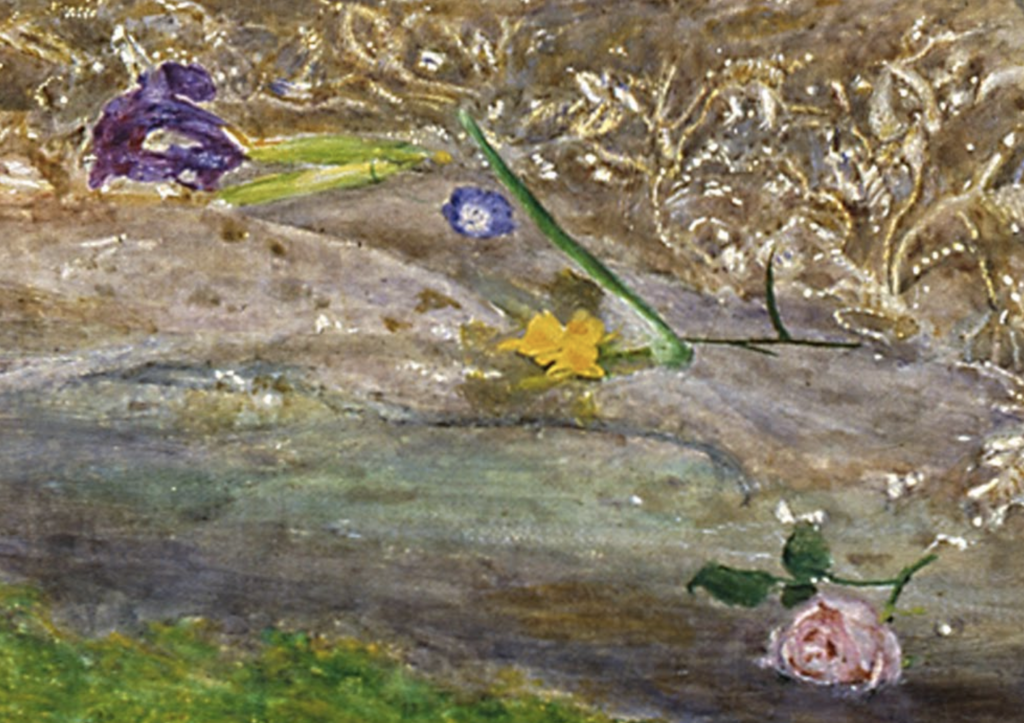
"Till our scale turn the axle. O rose of May,
Hamlet, Act Four Scene V (According to Gerard's Herball, the rose of May is likewise known equally the Cannell Rose)
Dear maid, kind sister, sweet Ophelia!
O heavens, is 't possible a young maid's wits
Should exist as mortal equally an former man'southward life?"
The Language of Ophelia'southward Flowers
6.
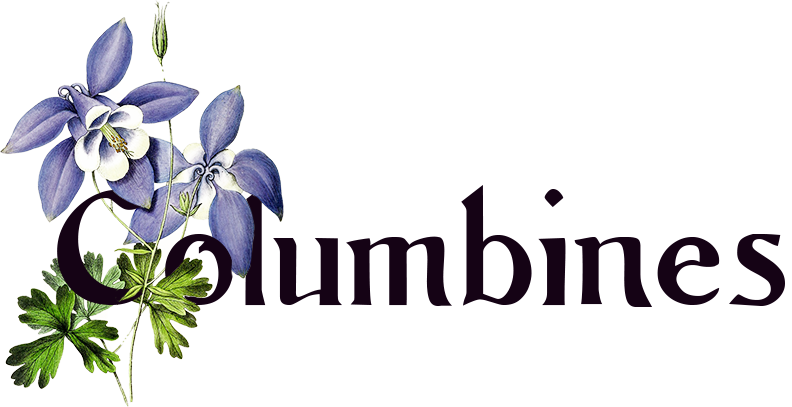
Victorian Significant of Columbine: Folly
The three-parted leaves of this poisonous flower came to symbolize the Holy Trinity, while the dove-like cluster of spurs represented the Holy Spirit (Thomas and Faircloth 84). Notwithstanding, the Columbines (about likely Aguilegia vulgaris, or the Mutual Columbine) Ophelia gives out symbolized Gertrude's adultery and her date in cuckoldry (Thomas and Faircloth 85).
There's fennel for you, and columbines.—In that location'southward rue for you, and here's some for me. We may call it "herb of grace" o' Sundays.—Oh, you must wear your rue with a departure.—There'south a daisy. I would give you some violets, but they withered all when my father died.
Village, Deed IV Scene 5
The columbine flower does not seem to be present in Millais's Ophelia.
7.
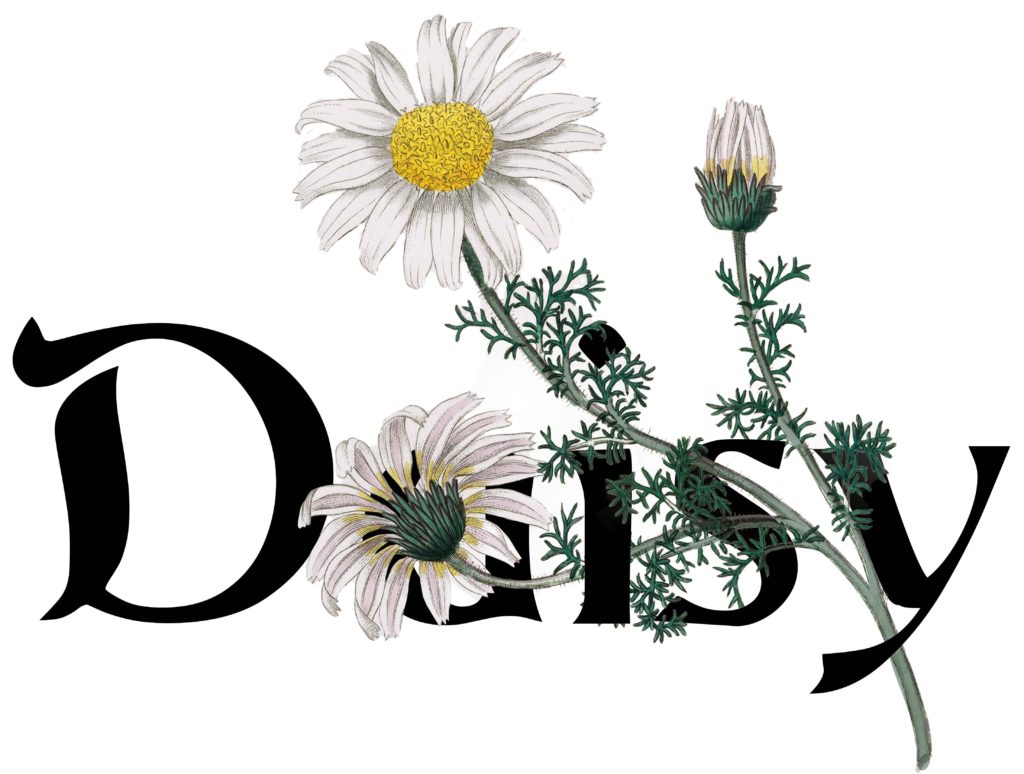
Victorian Meaning of Daisy: Innocence
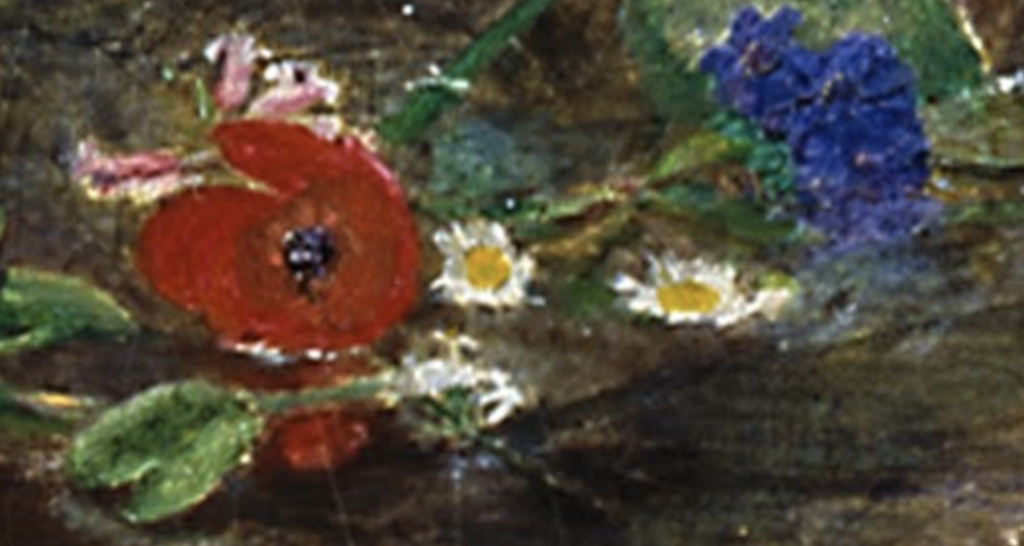
The bloom of the English Daisy (Bellis perennis), a native wildflower of Britain, is short-lived. Consequently, daisies appropriately symbolize sadness, grief and death (Quealy 192). Shakespeare also plays on the daisy's association with kid-like innocence as Ophelia weaves them into her own garland.
"There with fantastic garlands did she come up
Village, Act Four Scene Vii
Of crowflowers, nettles, daisies, and long purples."
The Linguistic communication of Ophelia'south Flowers
8.
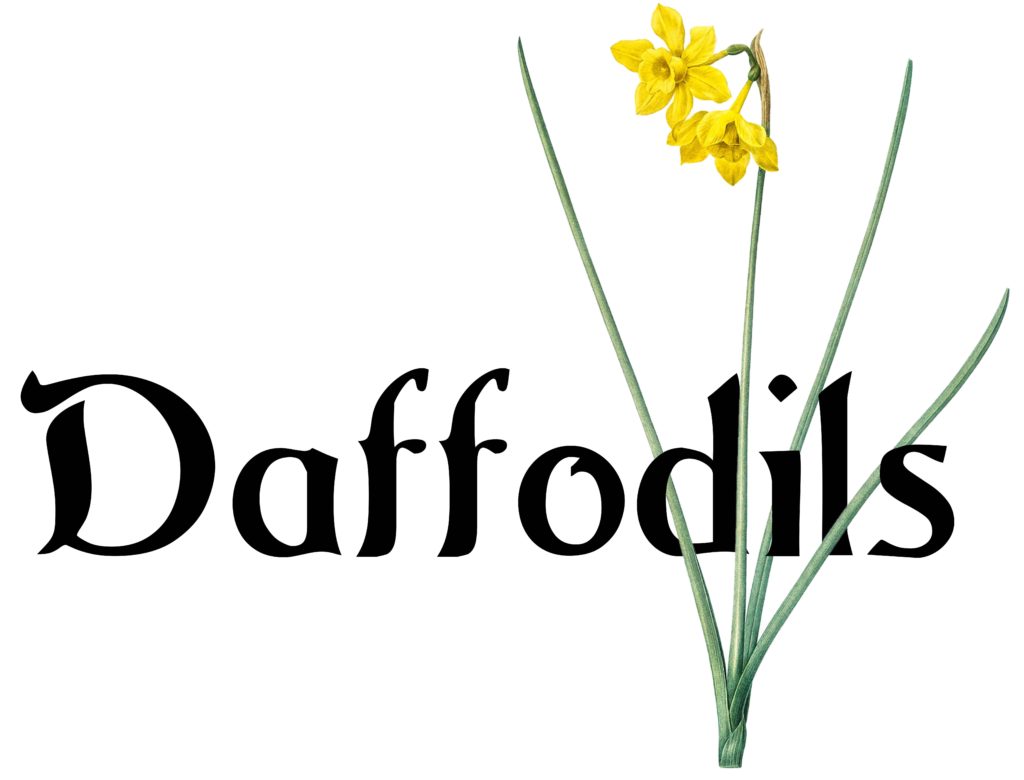
Victorian Meaning of Daffodil: Regard
"The Daffodillies make full their loving cup with tears."
John Milton, Lycidas
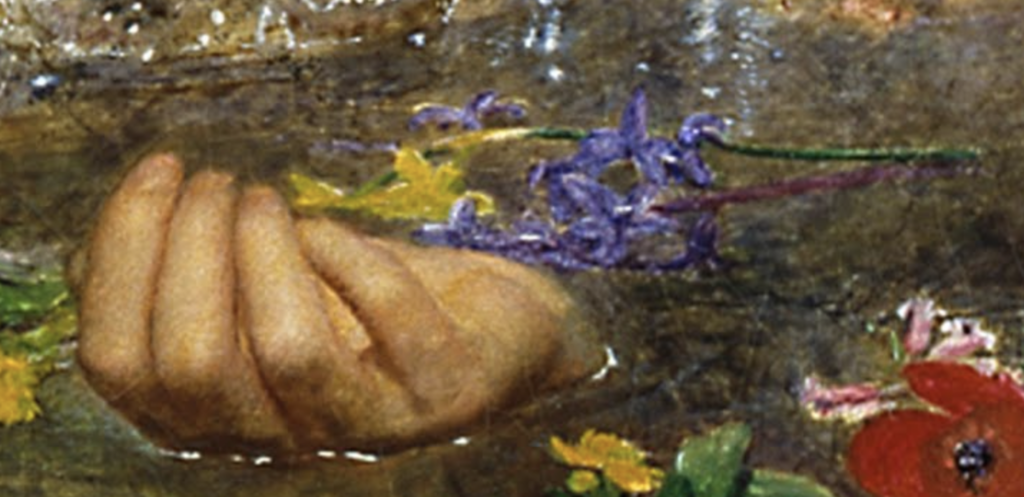
I believe the brownish sheath on the green stem near Ophelia's right palm is most representative of the stalk of a Daffodil.
The Wild Daffodil (Narcissus pseudo-Narissis) was readily found in the fields of England during both Shakespeare's and Millais'southward fourth dimension (Ellacombe 74) . In add-on, the Pre-Raphaelites highly revered Keats, Shelley, Wordsworth and Milton, all of whom wrote on the form of Daffodils (Ellacombe 72).
"In its general expression the Poet'south Narcissus seems a type of maiden purity and dazzler, withal warmed by a love-breathing fragrance; and yet what innocence in the large soft eye, which few can rival amidst the whole tribe of flowers."
Dr. Frobes Watson's description of the poetic course of the Daffodil (Ellacombe 75)
It may a far accomplish on my function as the flower loving cup is indistinguishable, only would information technology not be a romantic symbol on Millais'southward part?
nine.
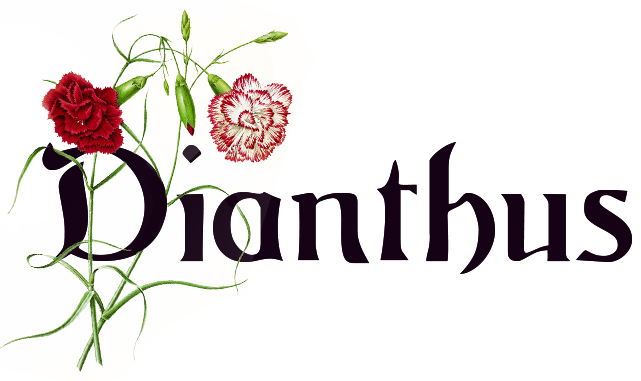
Victorian Pregnant of Carnation: Atlas! for my poor heart
Victorian Meaning of Variegated Pink: Refusal
Victorian Meaning of Gillyflower: Bonds of affection
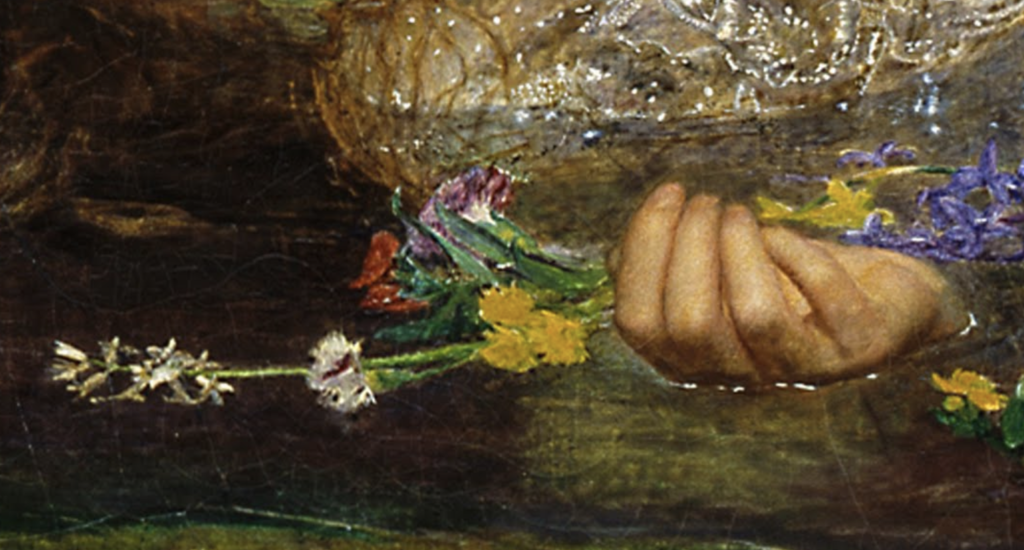
I take plant no other confirmation of this, but I am completely convinced that I come across Carnations and Pinks (flowers of the genus Dianthus) amongst the floating bouquets. Both carnations and pinks were mutual during the Elizabethan era equally they were a remedy for heart pain. During the Victorian Era, carnations, also known as Gillivors and Gilly-tiesels, were heavily cultivated and utilized in many Pre-Raphaelite paintings as symbol of "a woman's pure love" (Mancoff 82).
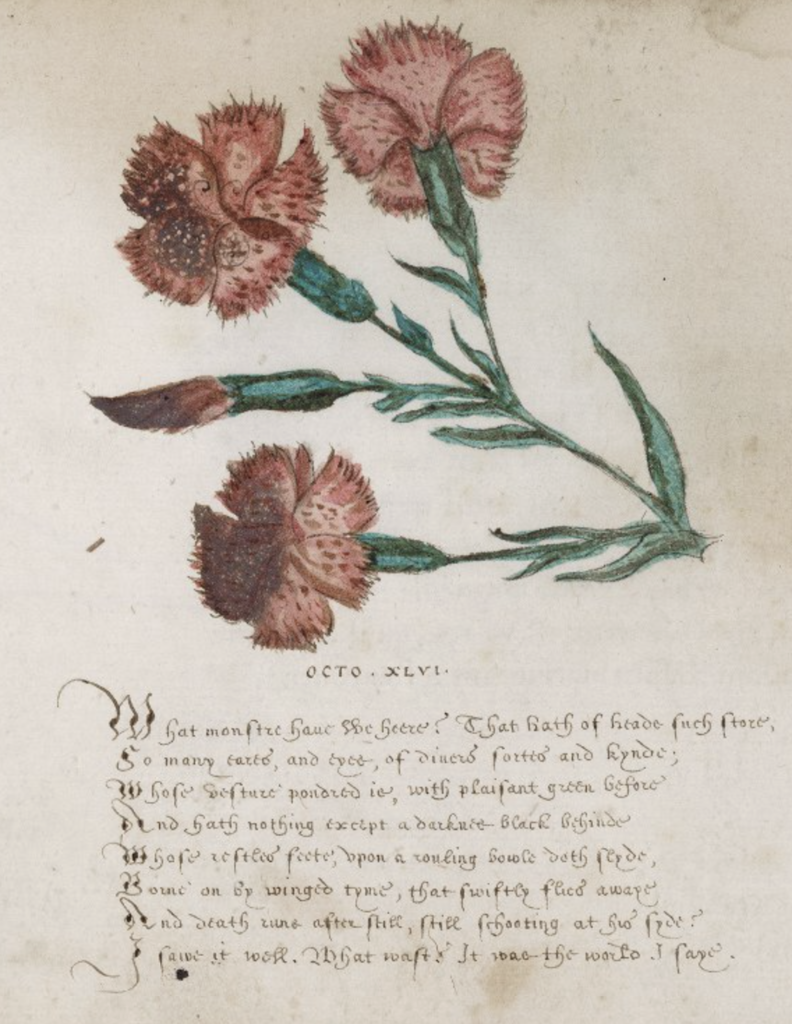
Though Dianthus
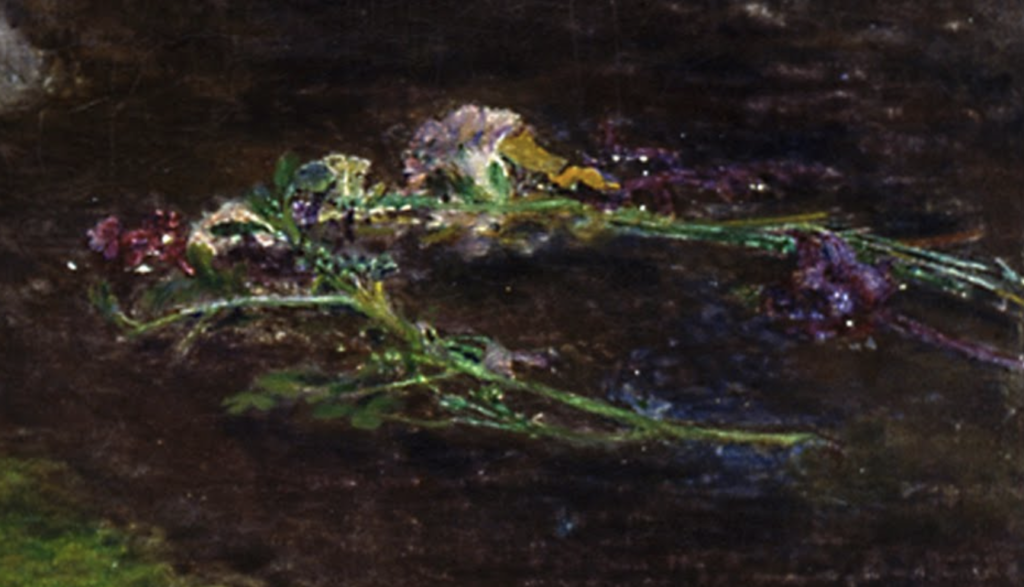
It is noteworthy that carnations were as well a popular component of Roman, Greek and Athenian garlands (Ellacombe 43).
10.
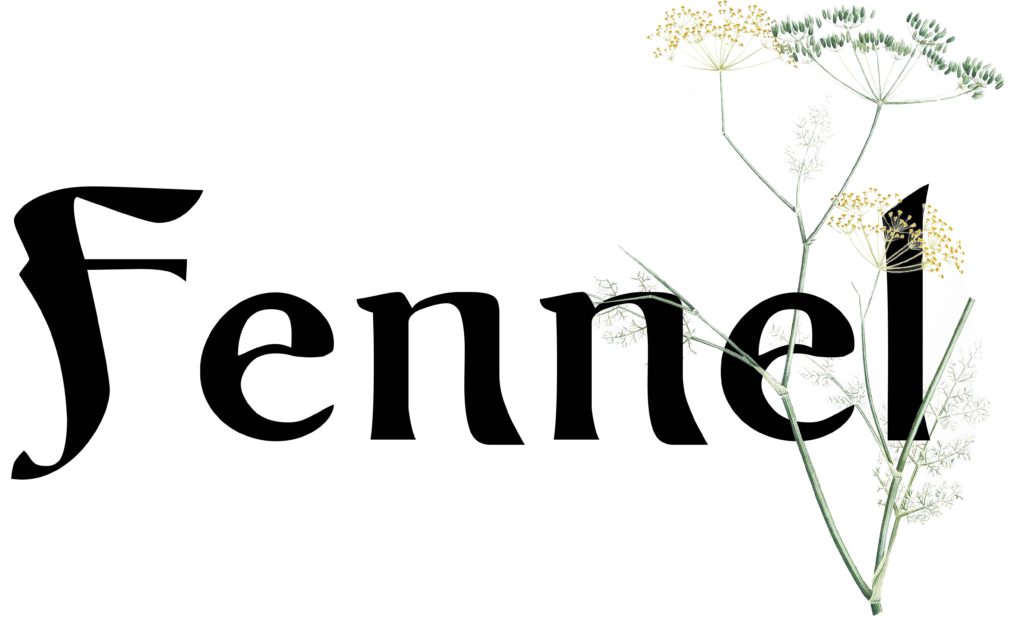
Victorian Meaning of Fennel: Worthy of all praise; Forcefulness
Though I do not believe information technology is featured in Millais'south painting, Fennel (Foeniculum vulgare) is a significant botanical symbol in Hamlet.
"In that location's fennel for you, and columbines."
Village, Act 4 Scene V
This sacred herb is used equally an "emblem of flattery" in literature and art. So, to give fennel is to flatter the recipient (Ellacombe 91).
11.
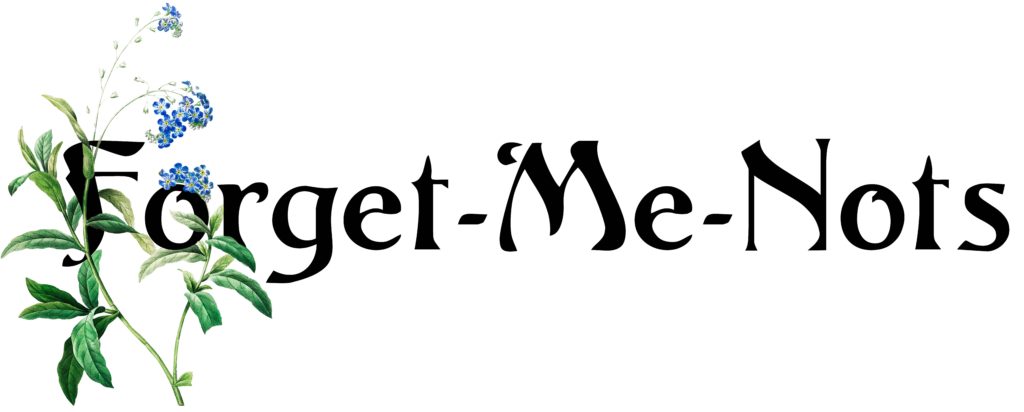
Victorian Language of Forget-Me-Nots: True honey; Forget me not
As the name suggests, this flower represents the hopes of everlasting remembrance. Equally the Plant Curator suggests, these are most likely H2o Forget-Me- Nots (Myosotis scorpioides) on either side of the stream.
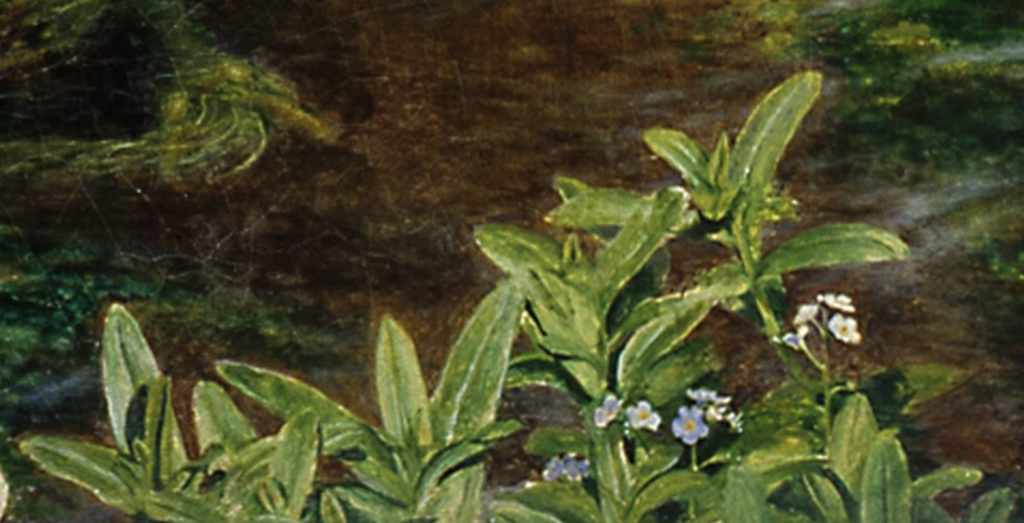
12.
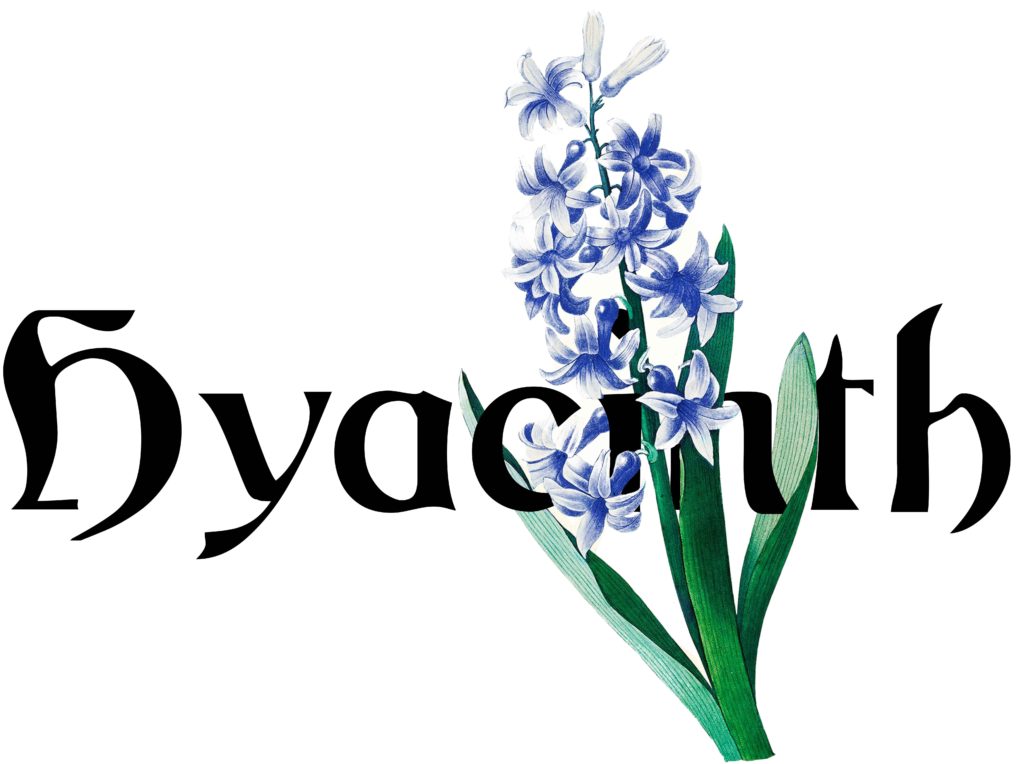
Victorian Meaning of Hyacinth: Sport, Game, Play
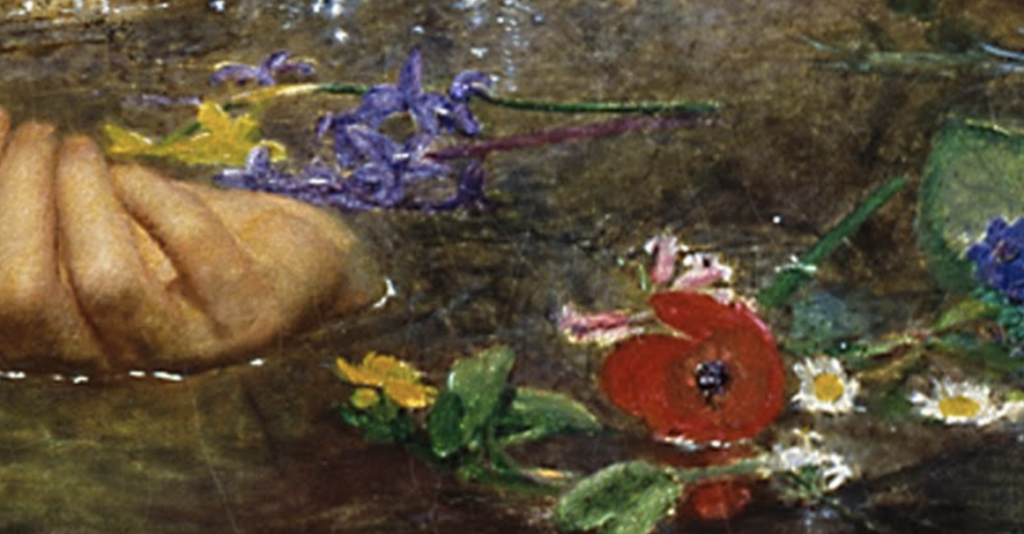
I believe that the undefined imperial flowers, similar to the Mutual Hyacinth (Hyacinthus orientalis), may be present due to the confusion regarding Shakespeare's "crow-flowers." However, I believe the hyacinth's appearance is more symbolic. I will provide a subsequent postal service to further explain my conjecture in the image to the right.
13.
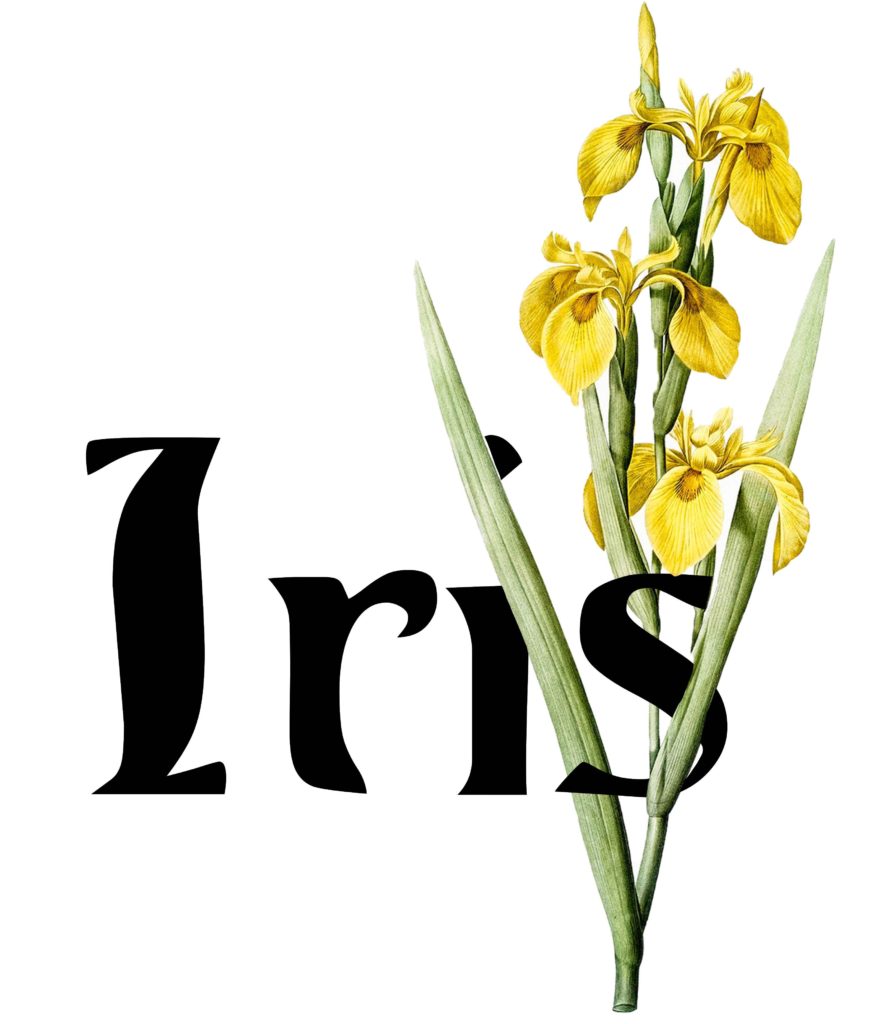
Victorian Meaning of Iris: Message
Based on the stem's texture and tonal coloration, I believe that Millais has depicted both the English language Iris (Iris latifolia) and the Yellow Flag Iris (Iris pseudacorus). In further support of the yellow flag iris identification, it is known to be commonly plant along a water source (Ellacombe 101).
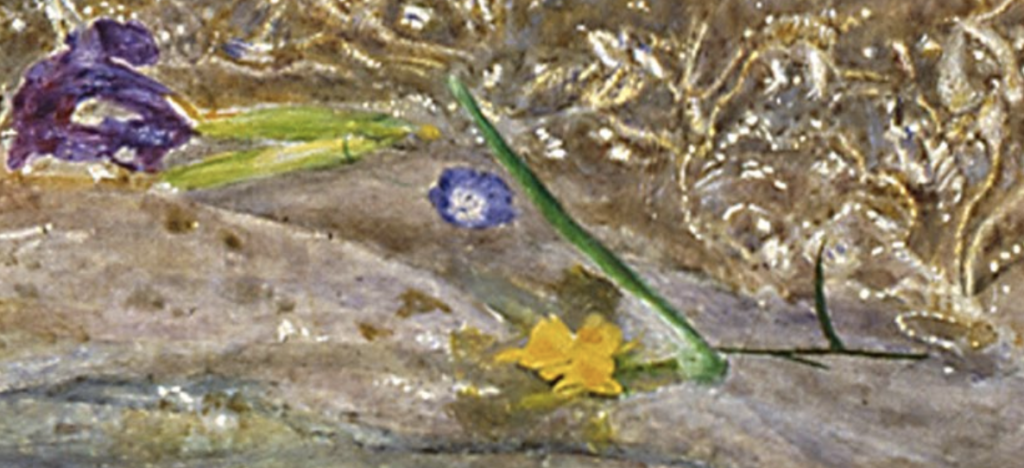
Every bit the Victorian pregnant implies, the iris was named after the messenger of the Olympians, who is traditionally believed to aid immature girls into their afterlife subsequently irises have been placed on their grave. The Pre-Raphaelites also used the iris to symbolize "lost beloved and silent grief" (Mancoff xvi). In add-on, co-ordinate to French mythology, majestic irises were believed to accept turned from gold to purple as a symbol of the mourning of Jesus (Mancoff 34).
xiv.
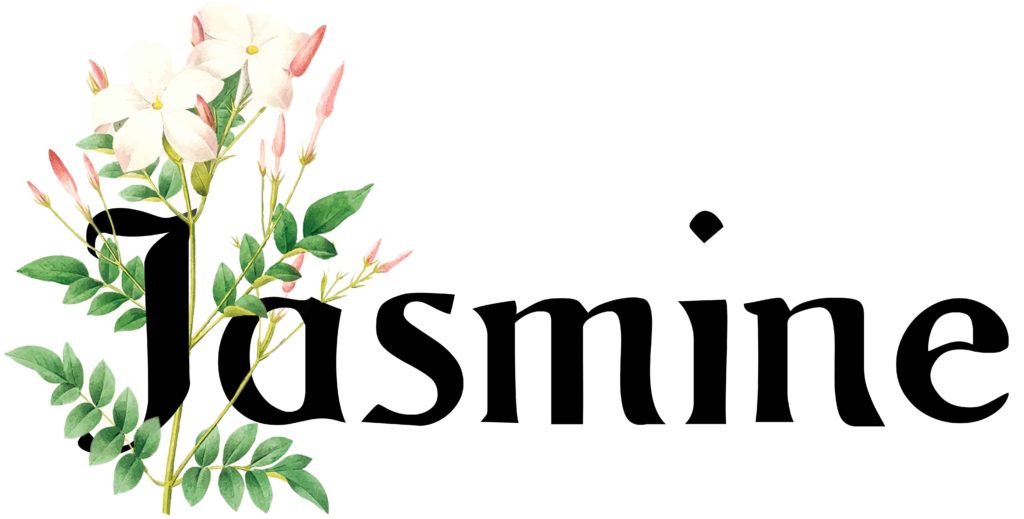
Victorian Significant of Jasmine: Amiability
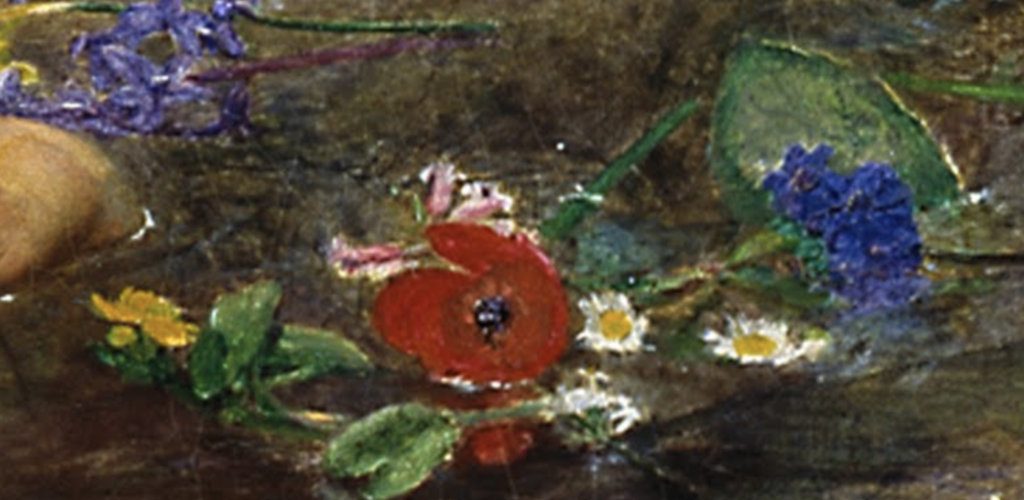
If I am correct in identifying the pinkish underside of the flowers in the particular image to the right as White Jasmine (Jasminum polyanthum), then this will not be Millais'south first time painting jasmine. Equally Millais depicted in The Bridesmaid (1851), brides of the Victorian Era wore jasmine as a symbol of "wedded elation" (Mancoff 26). Though I have yet to determine the symbolic meaning that could have been meant by Millais in Ophelia, I hope to update this every bit my studies go along.
15.

Victorian Meaning of Marigold: Grief
"Marigolds on decease-beds blowing."
Shakespeare, Two Noble Kinsmen
Notwithstanding another unconfirmed identification is the xanthous bloom to the left of the Reddish Poppy. I am confident that this is the Marsh Marigold (Caltha palustris).
"The wild Marsh Marigold shines like fire in swamps and hollows grey."
Lord Alfred Tennyson, The May Queen
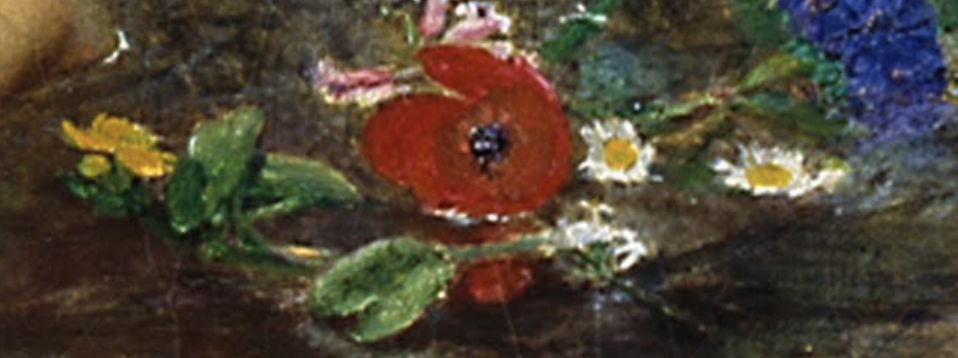
The marigold is known as the blossom of the dead in Mexico and a symbolic funeral offering in Aboriginal Greece (Foley 111). Similarly, through art and literature, the marigold has been associated with "decease, funerals, resurrection, and hope" (Thomas and Faircloth 222).
"The purple violets and marigolds
Shall,
a carpet, hang upon thy grave as While summer days do terminal."
Shakespeare, Pericles, Prince of Tyre
xvi.
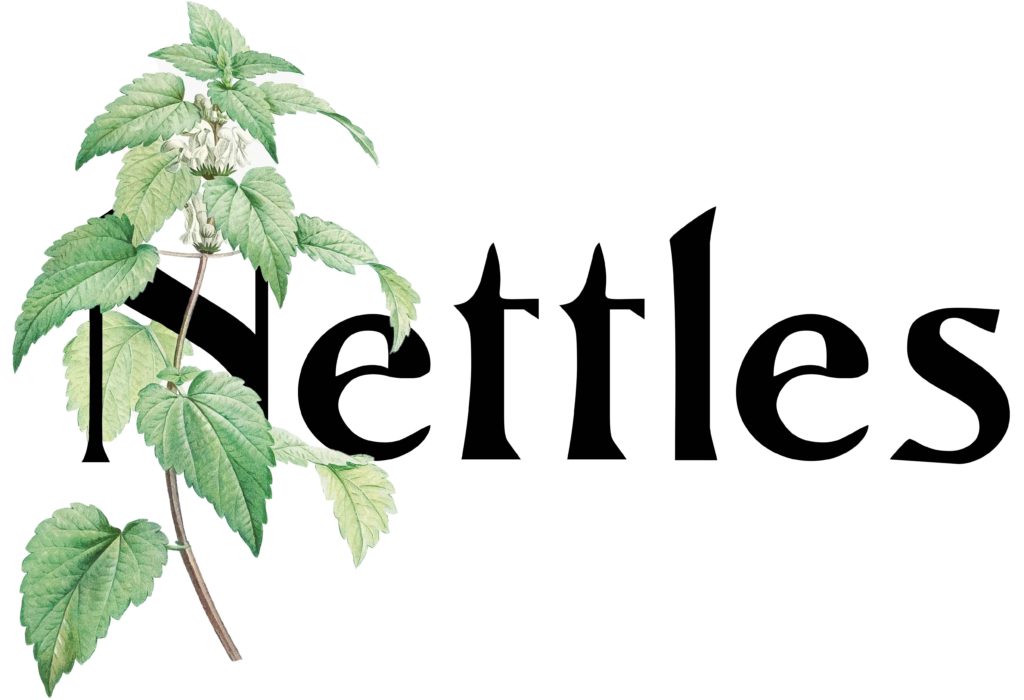
Victorian Meaning of Burning Nettle: Slander
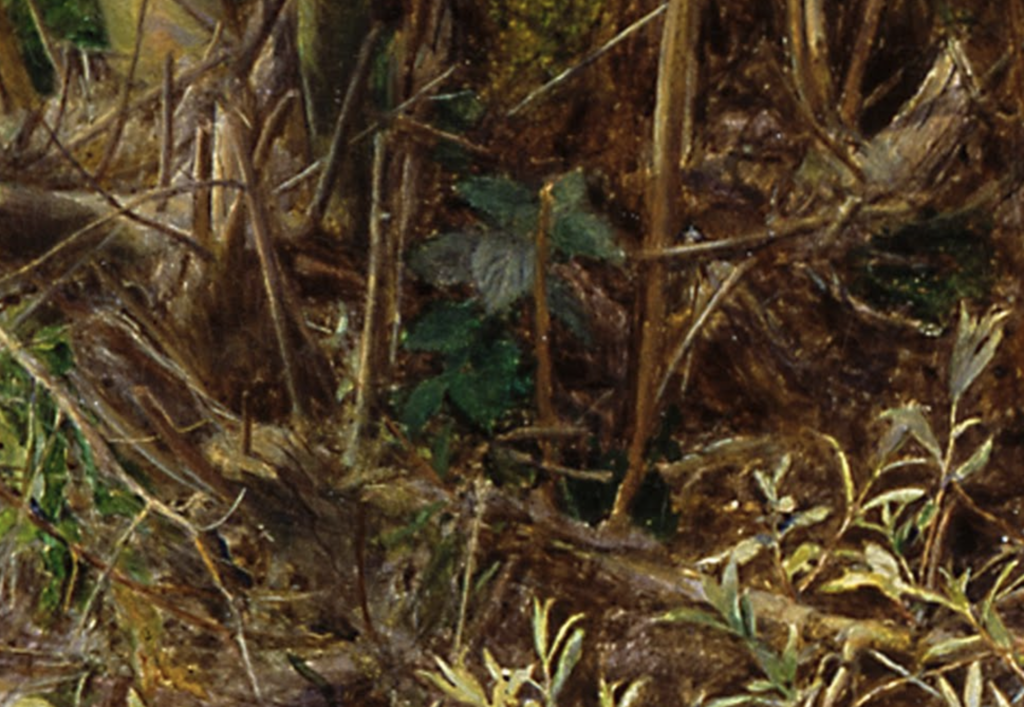
The leaves of the Stinging Nettle (Urtica dioica) are present between the willow branches of Millais's Ophelia. Though this establish's qualities may be foreboding of hurting (i.e. Urtica is derived from uro, pregnant "to burn"), at that place is a fascinating history regarding the use of nettles as durable thread and as a food source (Ellacombe 187). As flavory as "nettle porridge" may sound, in both Millais's painting and Shakespeare's literary reference, nettles represent pain and slander.
17.
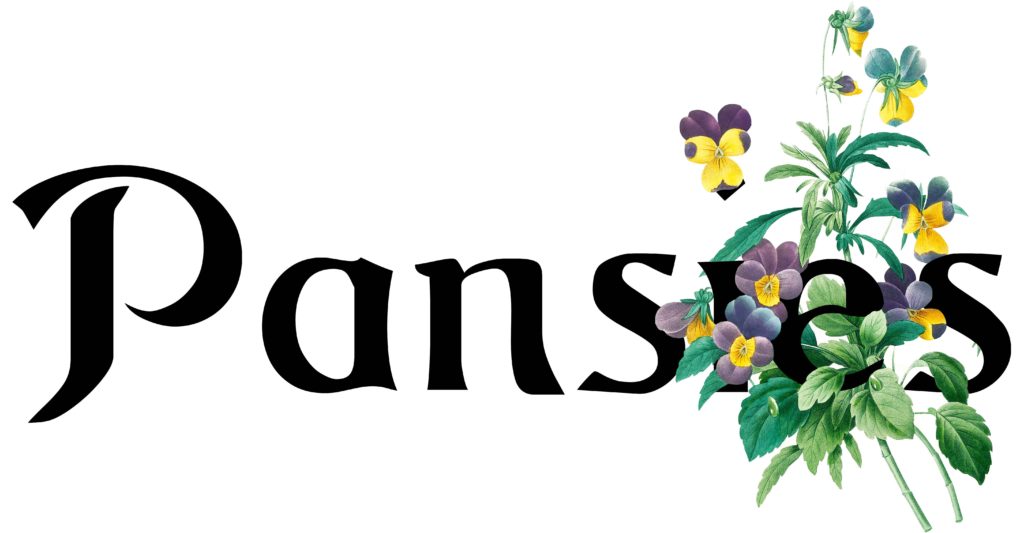
Victorian Language of Pansies: Love in Vain
Traditional herbalists credited the Pansy, also known every bit Heart'south Ease, every bit an anodyne for eye pain (Mancoff 78). The pansies depicted in Millais'south painting resemble the coloring and class of a Wild Pansy (Viola tricolor).
Information technology is thought that the proper name "pansy" is derived from the French discussion pensées, meaning thoughts (Ellacombe 207).
"And there is pansies, that's for thoughts."
Hamlet, Human action IV Scene Five
Shakespeare's ofttimes referred to this flower past its clearly symbolic proper name, Honey-in-idleness.
"Before milk-white, now majestic with love's wounds
And maidens call it Beloved-in-Idleness."
Shakespeare, Midsummers Nighttime's Dream
18.

Victorian Significant of Flos Adonis: Painful Recollections
According to Tate Gallery, the minor red flower seems to reflect a blooming Pheasant's Eye (Adonis annua), also known as the Adonis' Flower. Unfortunately, they exercise non go into farther detail regarding the reasoning behind their identification. My studies on the mythos and symbology of the Pheasant's Eye continues.
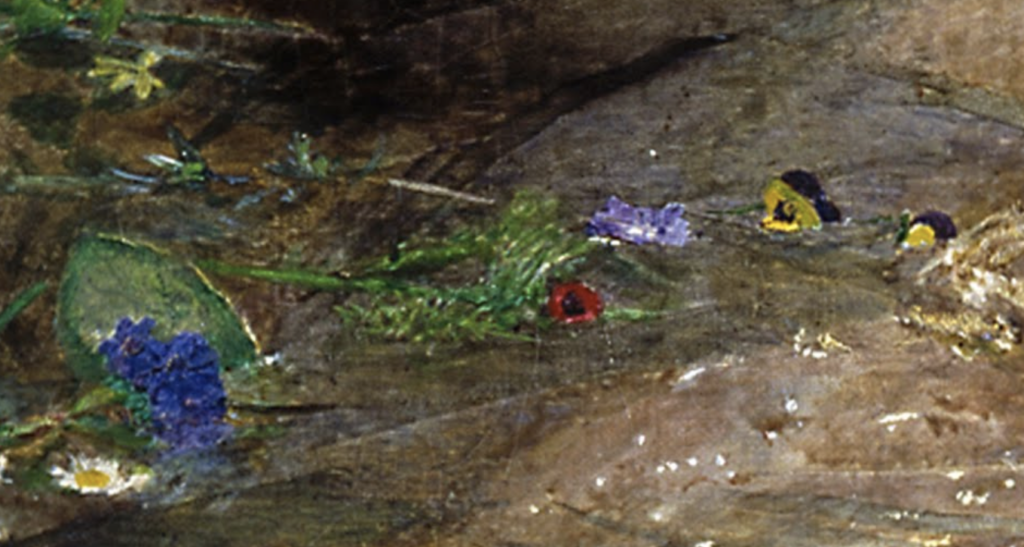
The Adonis' Flower was named after Adonis, the mortal lover of Aphrodite. While weeping over Adonis'south dying body, Aphrodite's tears and Adonis'due south blood formed the anemone bloom. Though the Adonis' Flower we know today is non an anemone, they are both members of the Buttercup family (Ranunculaceae).
19.
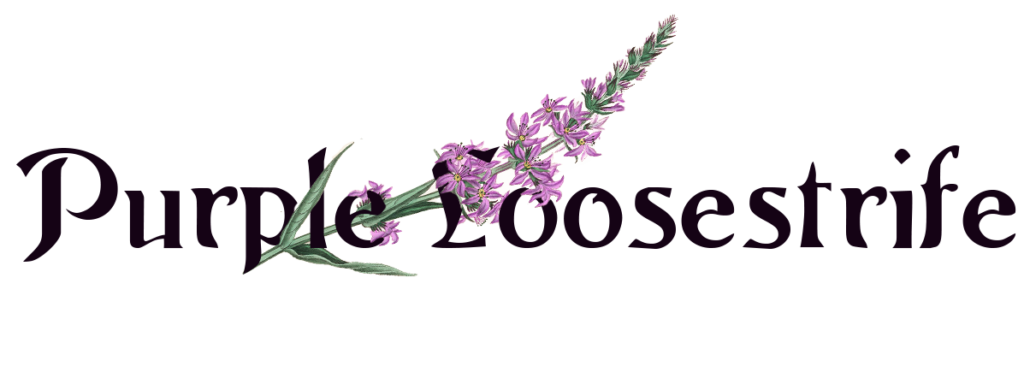
Victorian Significant of Purple Loosestrife: Pretension
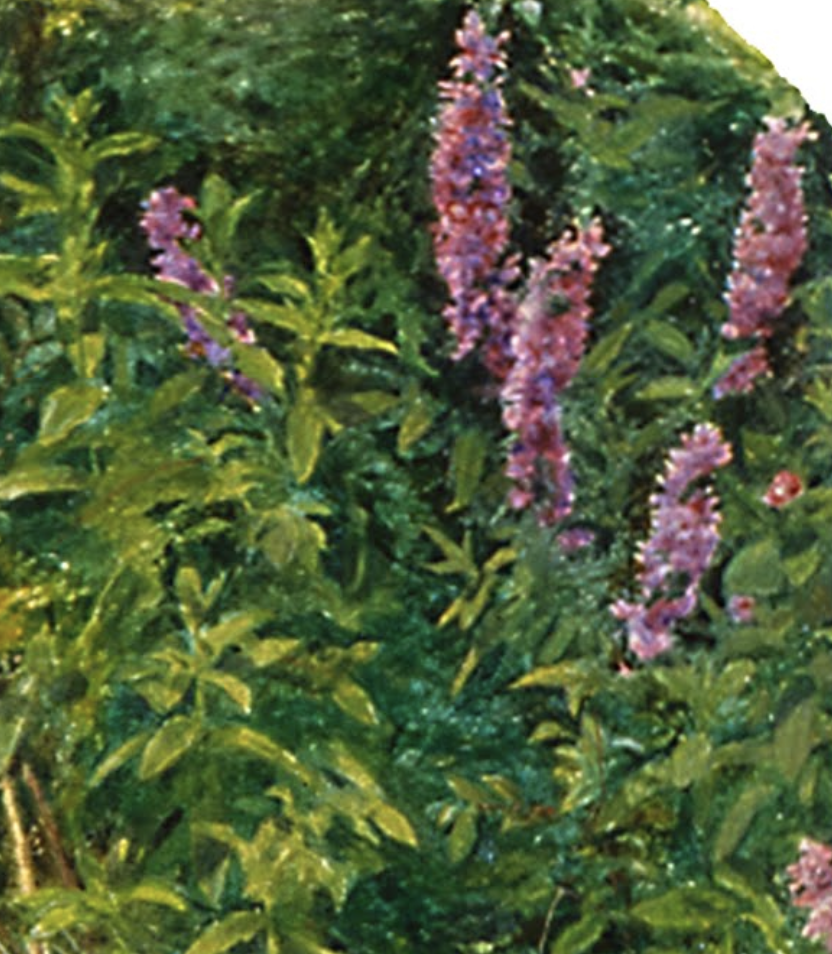
Millais portrayed the native plant purple loosestrife (Lythrum salicaria) in reference to Gertrude'south description of the "long purples" featured in Ophelia's drowning. Nevertheless, there has been a debate regarding the right flower that Shakespeare was referring to. Ellacombe dedicated the popular theory that the "long purples" were most likely any of the iii common majestic orchids constitute in England'south meadows: the green-winged orchid (Orchis morio), early marsh-orchid (Dactylorhiza incarnata) and early purple orchid (Orchis maculata) (Ellacombe 157). He further argued that their appendage-like stake roots fit Long Regal'due south alternative proper name: Dead Men'due south Fingers.
"Our common cold maids do Expressionless Men'southward Fingers call them."
Hamlet, Act Iv Scene VII
For Millais, the confusion of this reference may have been circumstantial every bit long purples were referred to as the royal loosestrife found in the marshes of the English language countryside during the Victorian Era. For instance, John Clare writes of the "tufty spikes" that are characteristic of loosestrife, rather than meadow orchids (Ellacombe 158).
"Gay Long-purples with its tufty spike;
he'd wade o'e shoes to reach it in the dyke."
John Clare, Village Minstrel (1821)
Similarly, Millais's setting is reminiscent of the botanical positioning in Lord Alfred Tennyson's poem A Chant:
"Round thee blow, self-pleached deep,
Bramble Roses, faint and pale,
And Long Purples of the dale."
Lord Alfred Tennyson , A Chant (1830)
A modern identification of Shakespeare's "Dead Men'due south Fingers" is given later.
20.
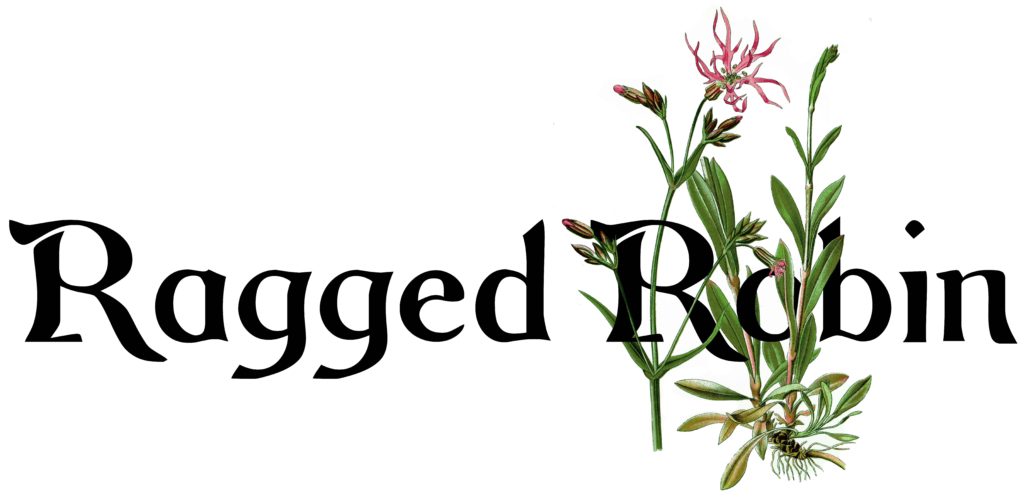
Victorian Meaning of Ragged Robin: Wit
The Crow-Bloom, or the Ragged Robin, was a popular Elizabethan garland component. In Herball, General Historie of Plants, Gerad notes how the Ragged Robin was used for "'garlands and crowns, and to deck up gardens'" (Ellacombe 64). Furthermore, at that place is a pregnant amount of evidence showing that Shakespeare often referred to guidance of Gerad's botany volume.
"At that place with fantastic garlands did she come
Hamlet, Act IV Scene VII
Of crowflowers, nettles, daisies, and long purples."
In Scotland, crow-flowers are actually referred to as wild hyacinth. Yet, as Ellacombe points out, Ophelia's garland consists of summer flowering plants, whereas the Hyacinth blooms in the Spring. Additionally, the ragged robin is a wetland perennial.
21.

Victorian Significant of Crimson Poppy: Death
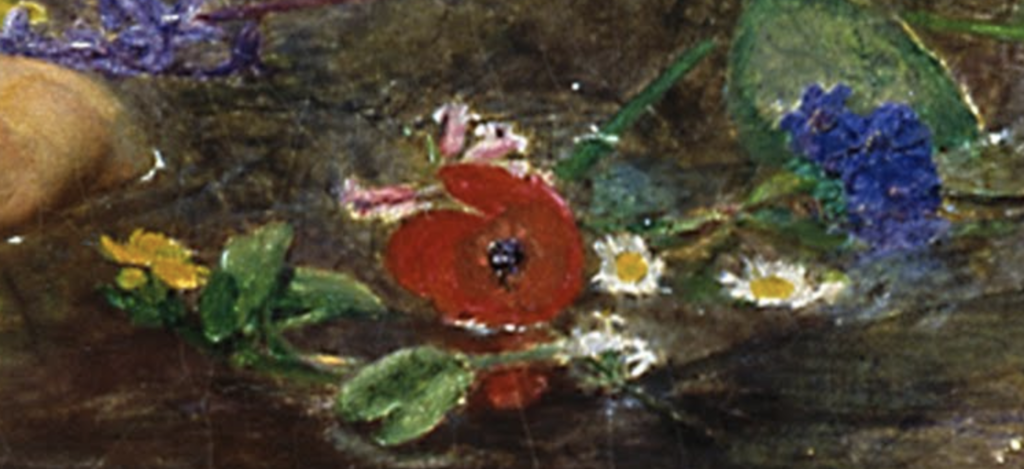
The Ruby-red Poppy was a popular symbol amongst the Pre-Raphaelites to foreshow death of the subject or to represent deep slumber.
According to Roman Mythology, the goddess of fields and mother of Persephone, Ceres, adorned poppies to commemorate her girl during winter (Mancoff 62).
22.
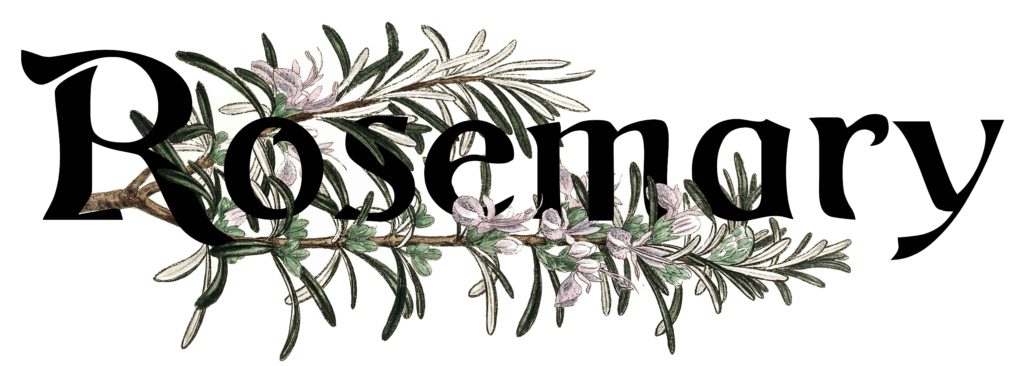
Victorian Pregnant of Rosemary: Remembrance
"Grow for two ends, it matter not at all,
Robert Herrick on the use of Rosemary
Exist't for my bridall or my buriall"
Though not depicted in Millais's Ophelia, during Shakespeare'southward time, rosemary was a highly appreciated herb and was usually used in both weddings and funerals (Ellacombe 273.
"Equally for Rosemarine, I lett it run alle over my garden walls, not only because my bees love its only because tis the herb sacred to remembrance, and therefore to friendship; whence a sprig of it hath a dumb linguistic communication that maketh it the chose keepsake at our funeral wakes and in our buriall grounds."
Sir Thomas More on his great admiration of Rosemary
"There'southward rosemary, that's for remembrance. Pray y'all, dear, recall."
Village, Act Four Scene V
23.
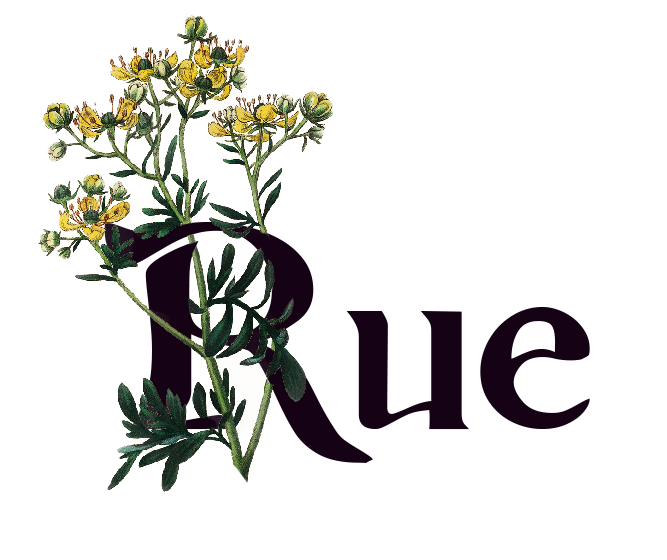
Victorian Significant of Rue: Repentance
"There's rue for you, and hither'due south some for me — we may call it herb of grace o' Sundays. Oh, y'all must wear your rue with a departure."
Hamlet, Act IV Scene V
The bitterness of Rue, or Herb of Grace, is said to the reasoning behind its association with the phrase "to rue" or to experience remorse for something. Thus, rue came to symbolize the act of repenting (Ellacombe, 1896).
24.
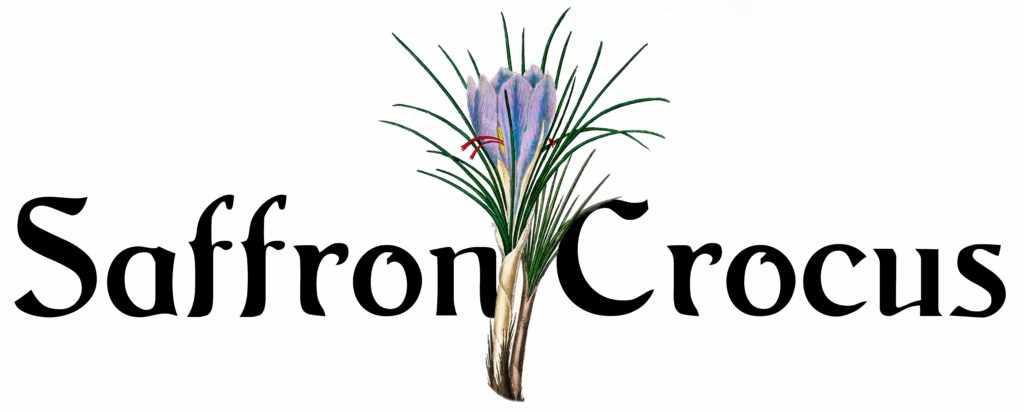
Victorian Meaning of Saffron Crocus: Mirth
Though I have no other account of this, I believe the majestic flower with 3 long stamens in the detail paradigm below to be Saffron Crocus. This delineation seems to exist lacking the usual 3 ruby-red stigmata, just the grasslike leaves farther support my attempt at botanical identification. I choose to believe that the stigmata were already harvested for seasoning or dye.
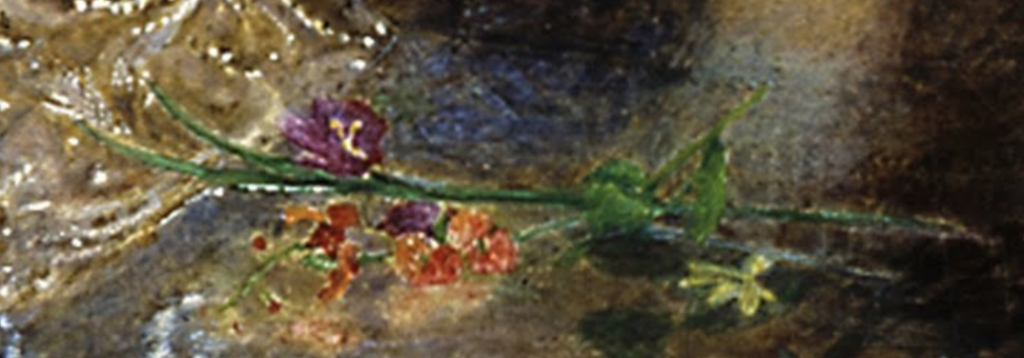
In improver, Millais may have been familiar with the symbolic usage of this plant in many of Shakespeare's plays: Winter'due south Tale, Comedy of Errors, Tempest and All'southward Well That Ends Well.
25.
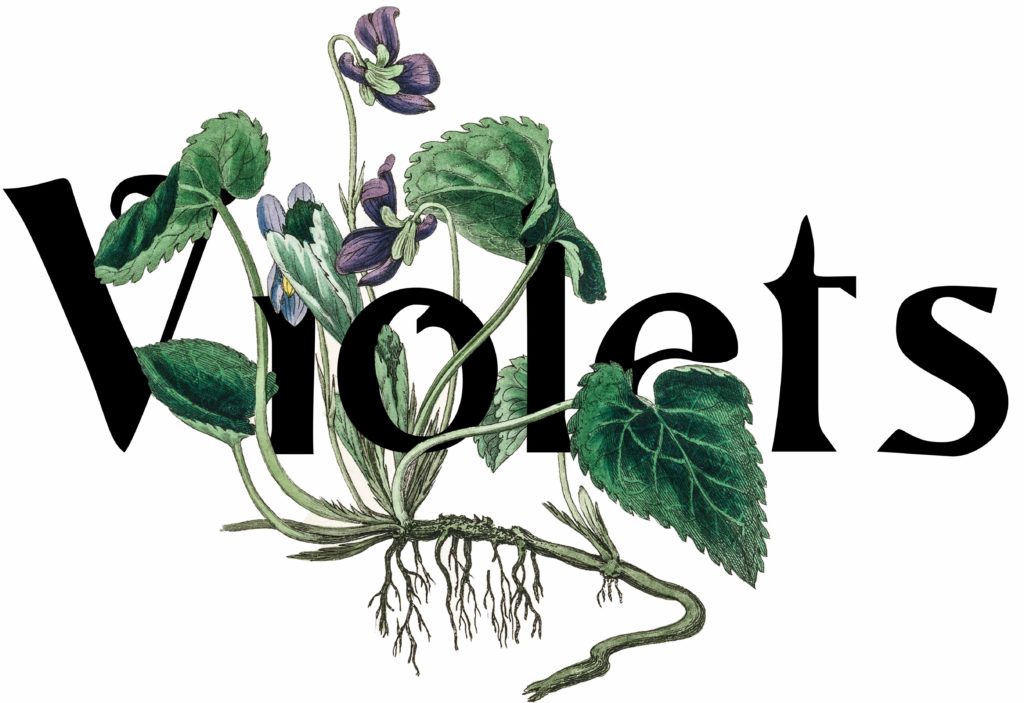
Victorian Meaning of Violet: Faithfulness
From chastity to youthful decease, Violets are laden with symbology (Tate). Their clan with early expiry may be reflective of their brusque-lived flowering flavor that ends "before the total beauty of summer had come," as shown in Henry Vaughan'southward poem Daphnis (Ellacombe 333).
"So Violets, so doth the primrose fall
At once the spring's pride and its funeral,
Such piece of cake sweets become off notwithstanding in their prime number,
Henry Vaughan, Daphnis
And stay not here, to wearable the soil of Fourth dimension;
While courser Menses'rs (which none would miss, if by;
To scorching Summers, and cold Autumns terminal."
Or when Laertes' hopes that violets grow from Ophelia'southward grave:
"Lay her i' the earth,
And from her fair and unpolluted flesh
May Violets spring!"
Hamlet, Act V Scene I
Shakespeare introduces the language of violets as Ophelia's brother, Laertes, compares the fragility and transiency of a violet's flower to the falsity and brevity of Hamlet's affection towards her:
"For Village and the trifling of his favor,
Hamlet, Deed I Scene III
Hold it a fashion and a toy in blood,
A violet in the youth of primy nature,
Forwards, not permanent, sweet, non lasting,
The perfume and suppliance of a minute.
No more."
Though Ophelia states that at that place are no violets to requite, Millais'southward Ophelia wears a necklace of what appears to be English Violets (Viola odorata).
"I would give you some Violets,
only they wither all when my father died."
Hamlet, Deed IV Scene V
26.
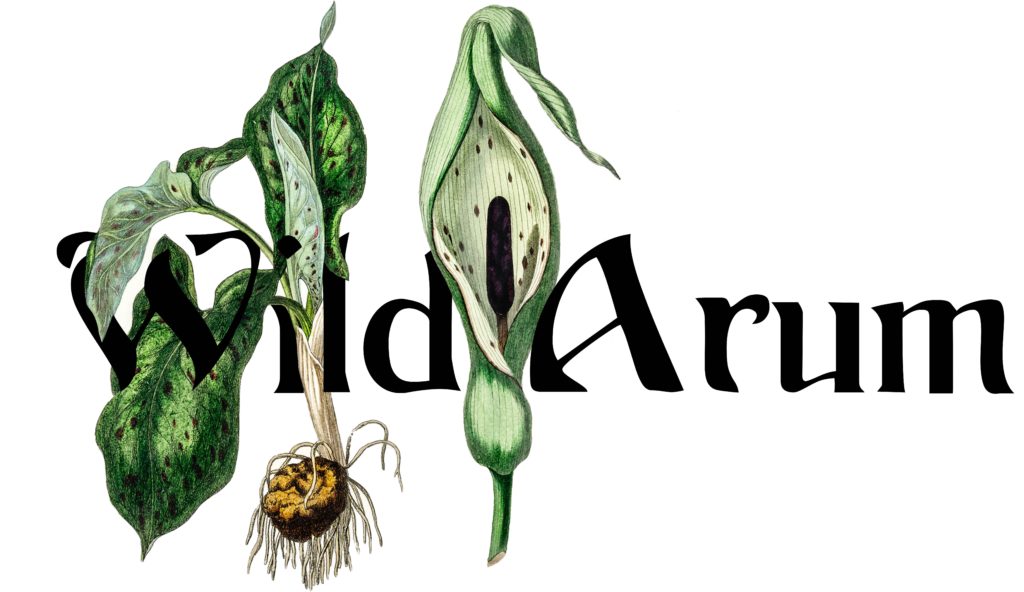
Victorian Meaning of Cuckoo Plant: Avidity
Though Ellacombe credits Shakespeare's "long purples" reference to the purple orchids institute in the local woodlands of England, the author of Flowers from Stratford-on-Avon (1852), Paul Jerrard, argues that Shakespeare undoubtedly is referring to the Wild Arum (Arum maculatum) (Ellacombe 157). Even the Director of the Shakespeare Birthplace Trust, Dr. Levi Fox, was in understanding with Jerrard's conjecture (Quealy 198).
I believe this supposition can hold upward merely based off the the rotting finger coloration and symbolic insinuation of the genital-like spadix (stem of flowers) emerging from the spathe (leaf-like feature of the Araceae family). Consequently, the Wild Arum was besides referred to as Lords-and-Ladies. This botanical symbology may align with theory that the floral drowning scene was as well emblematic of the "deflowering" of Ophelia.
"That liberal shepherds give a grosser proper name,
Hamlet, Act 4 Scene 7
Merely our cold maids do "dead men'south fingers" call them."
27.
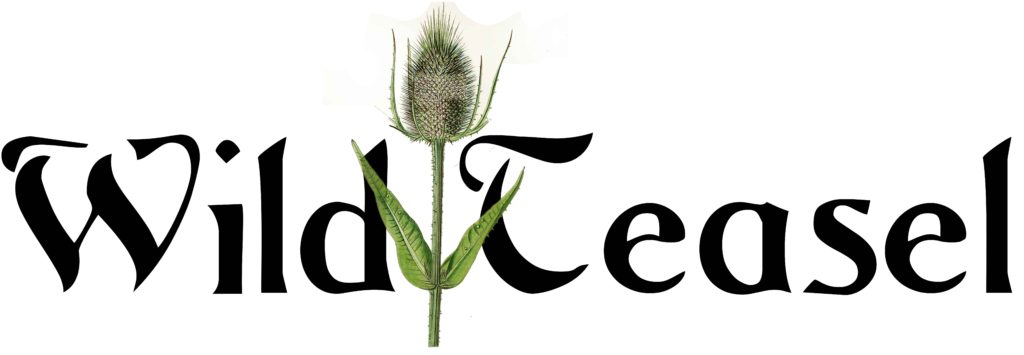
Victorian Meaning of Fuller's Teasel: Misanthropy
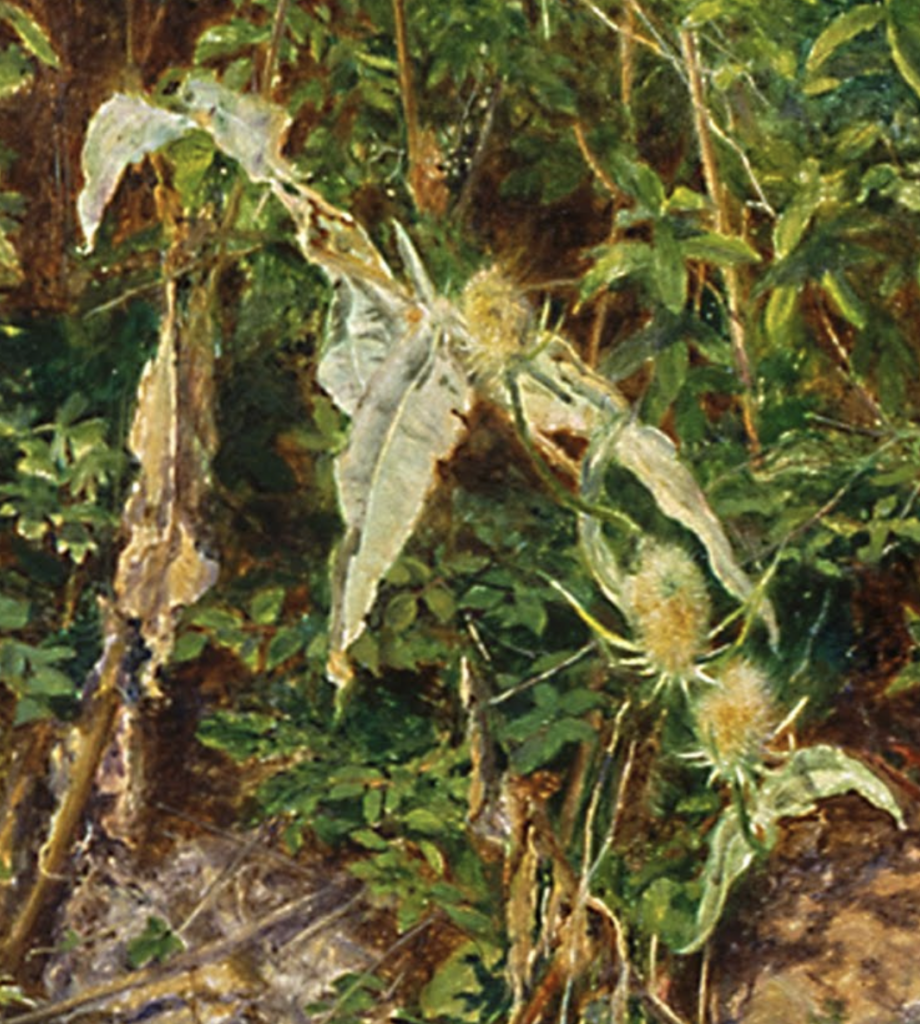
Wild Teasels (Dipsacus fullonum), or fuller'due south teasel, were virtually likely present along the Hogsmill River where Millais painted Ophelia's scene. I practise not believe this had a purely symbolic reason for being present, rather the incorporation of the wild teasels were a part of keeping true to nature.
28.
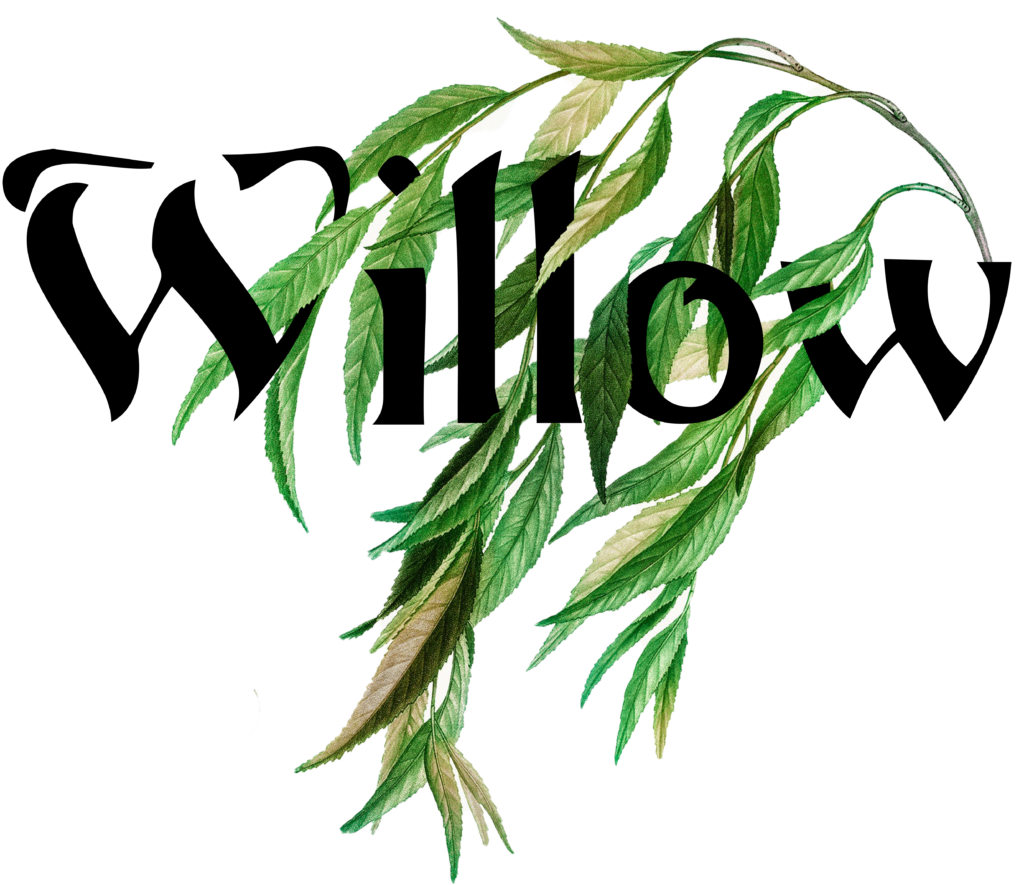
Victorian Pregnant of Willow: Mourning: Forsaken Love
The willow that Millais depicts and that Gertrude refers to in Hamlet is most likely the Fissure Willow (Salix fragilis). The Weeping Willow that often accompanies Ophelia in other paintings was not actually present in England during the Elizabethan Era. Fortunately for Millais, the stream embankments independent a cracked willow fitted with "pendant boughs."
"There is a willow grows cater-corner a brook
Hamlet, Deed IV Scene 7
That shows his hoar leaves in the glassy stream."
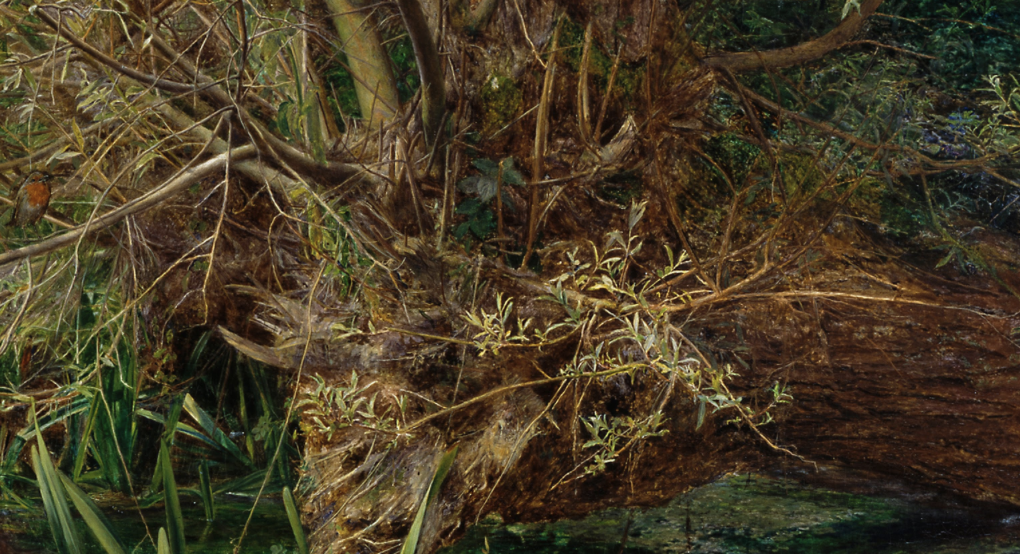
R E Due south O U R C E S
References
Barnard, George. Drawing from Nature: A Series of Progressive Instructions in Sketching, to Which Are Appended Lectures on Art Delivered at Rugby School. Forgotten Books, 2017.
Belanger, Michelle. Walking the Twilight Path: A Gothic Volume of the Expressionless.
Ellacombe, Henry. The Plant-Lore and Garden-Craft of Shakespeare. London, W. Satchell and Co, 1896.
Foley, Daniel. Herbs for Use and for Delight: An Anthology from the Herbarist. Dover Publications, 1974.
Graves, Robert. The Common Asphodel: Collected Essays on Poetry, 1922-1949. Haskell House, 1970.
Greenway, Kate. The Language of Flowers. London, 1884.
Mancoff, Debra. The Pre-Raphaelite Language of Flowers . Prestel, 2012.
Millais, John. The Life and Messages of Sir John Everett Millais. London, Methuen & Co., 1899.
"Ranunculus penicillatus." Online Atlas of the British and Irish Flora.
Riggs, Terry. "Ophelia." Tate, Feb. 1998.
"Species list for Millais' Ophelia anyone?." Plant Curator, xv April 2014.
Thomas, Vivan and Nicki Faircloth. Shakespeare's Plants and Gardens: A Dictionary. The Arden Shakespeare, 2016.
Quealy, Gerit. Botanical Shakespeare: An Illustrated Compendium of All the Flowers, Fruits, Herbs, Copse, Seeds, and Grasses Cited by the World's Greatest Playwright. New York, Harper Collins Publishers, 2017.
Source: https://thepreraphaelitepleasaunce.com/the-language-of-ophelias-flowers/
0 Response to "Art From the Romantic Period John Everett Millais Ophelia Paintings"
Post a Comment